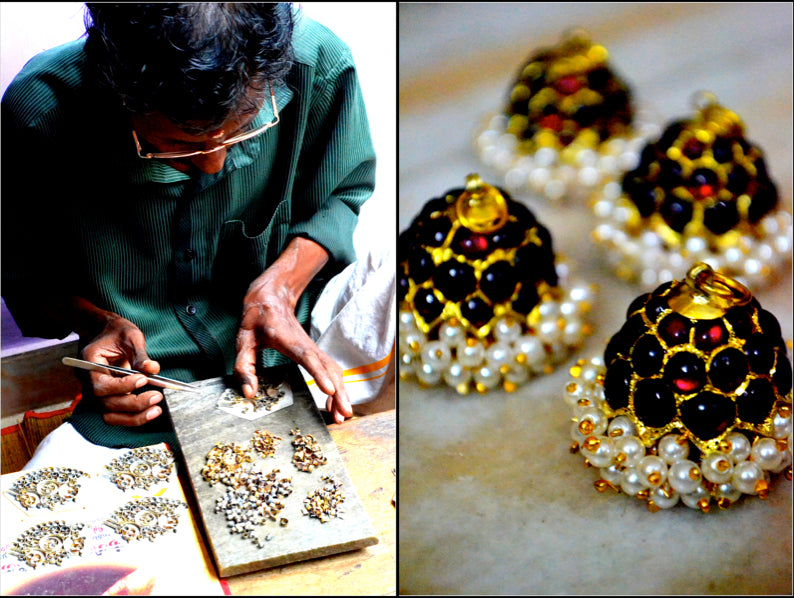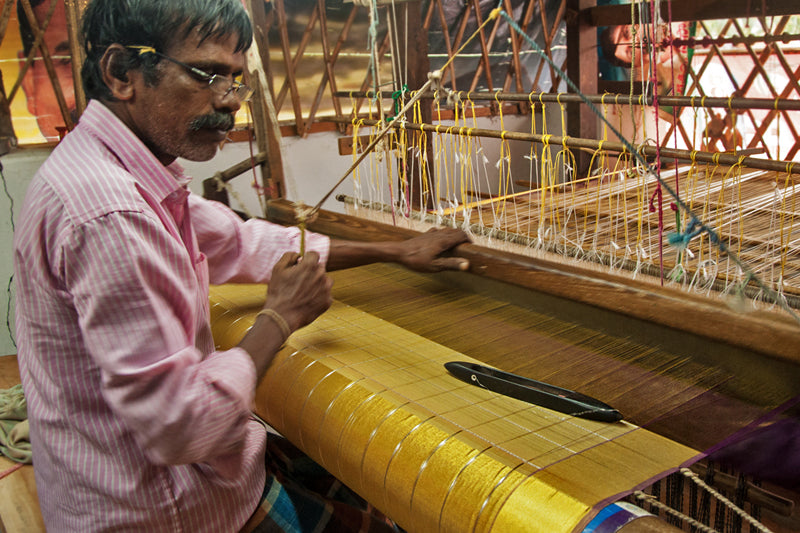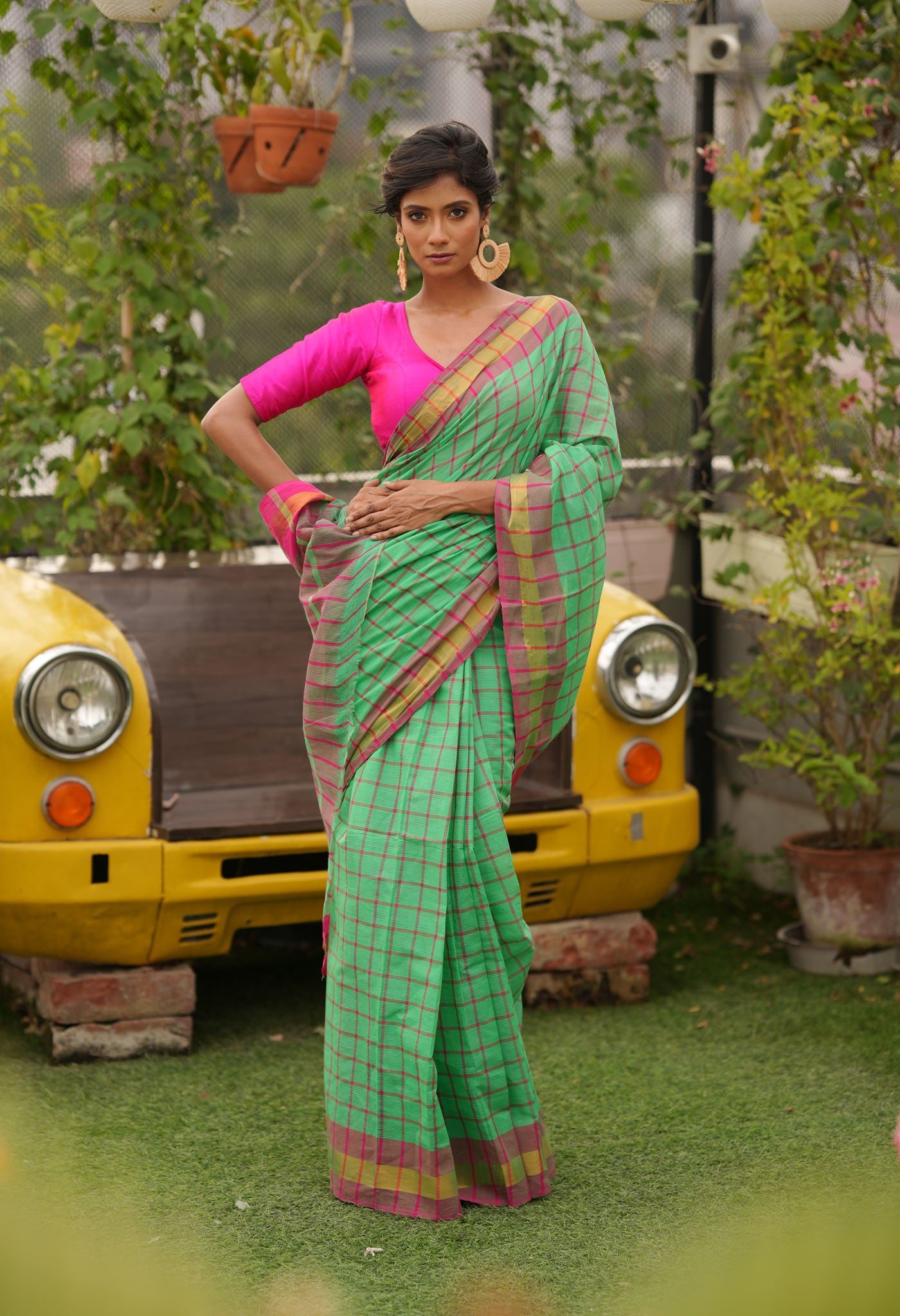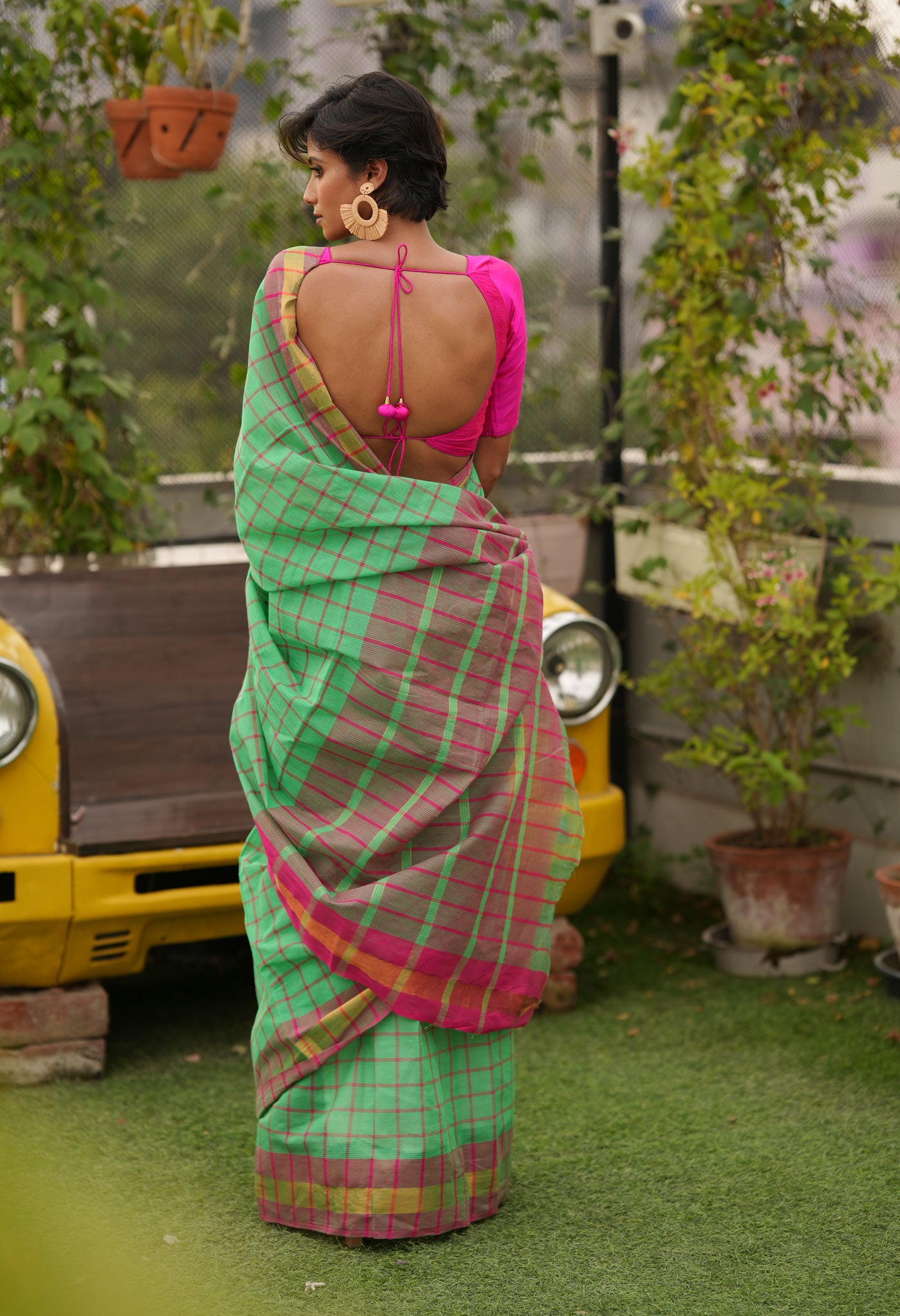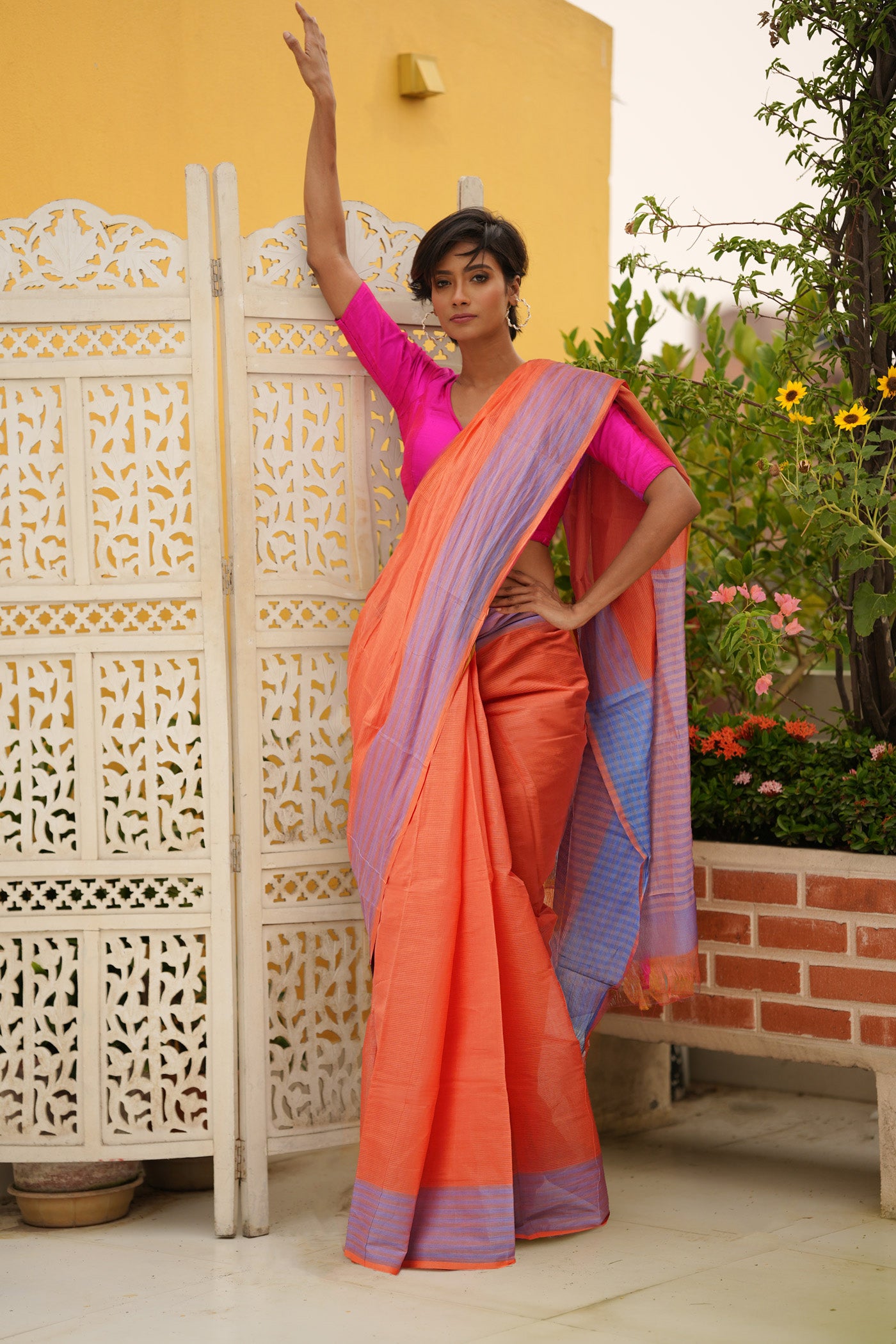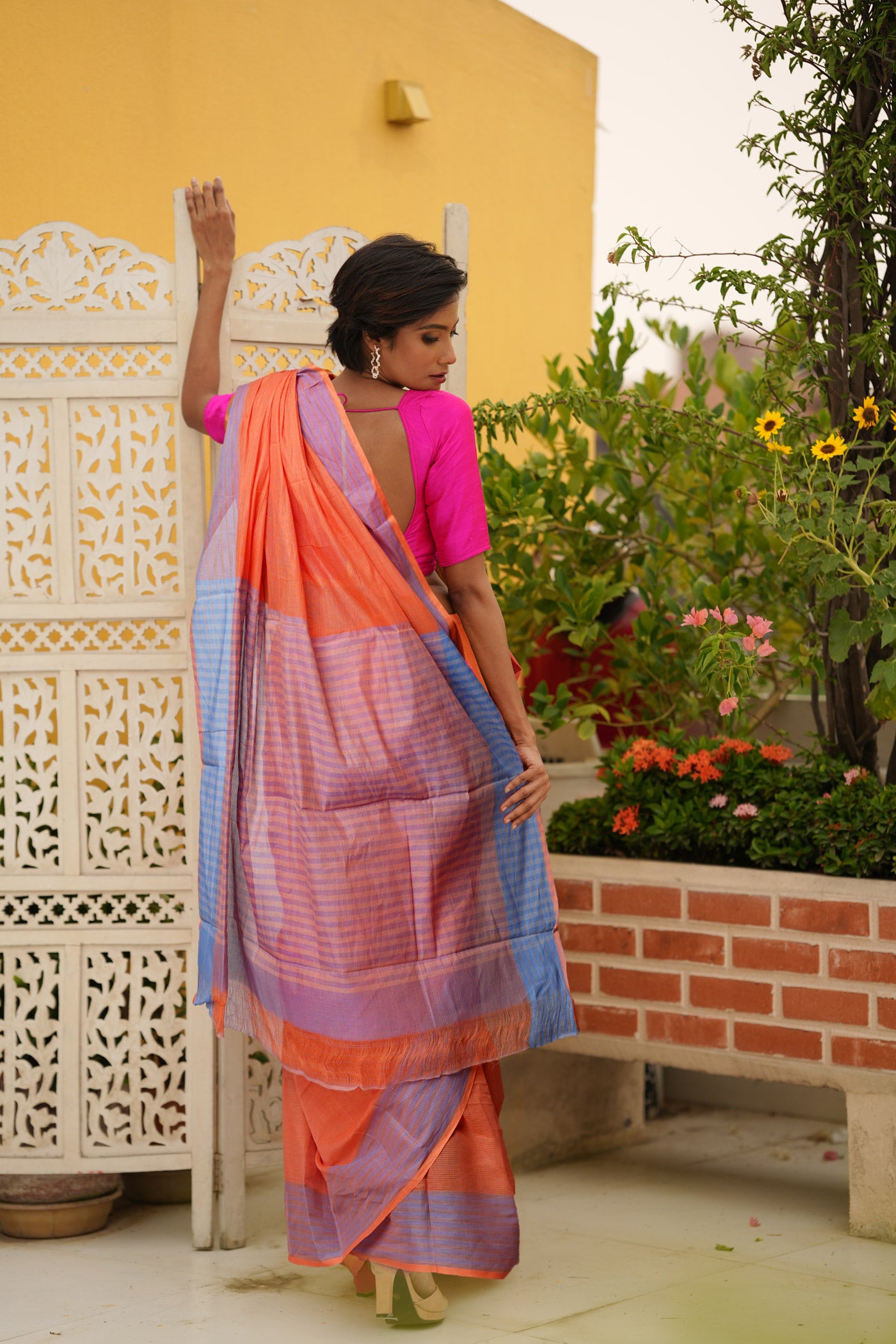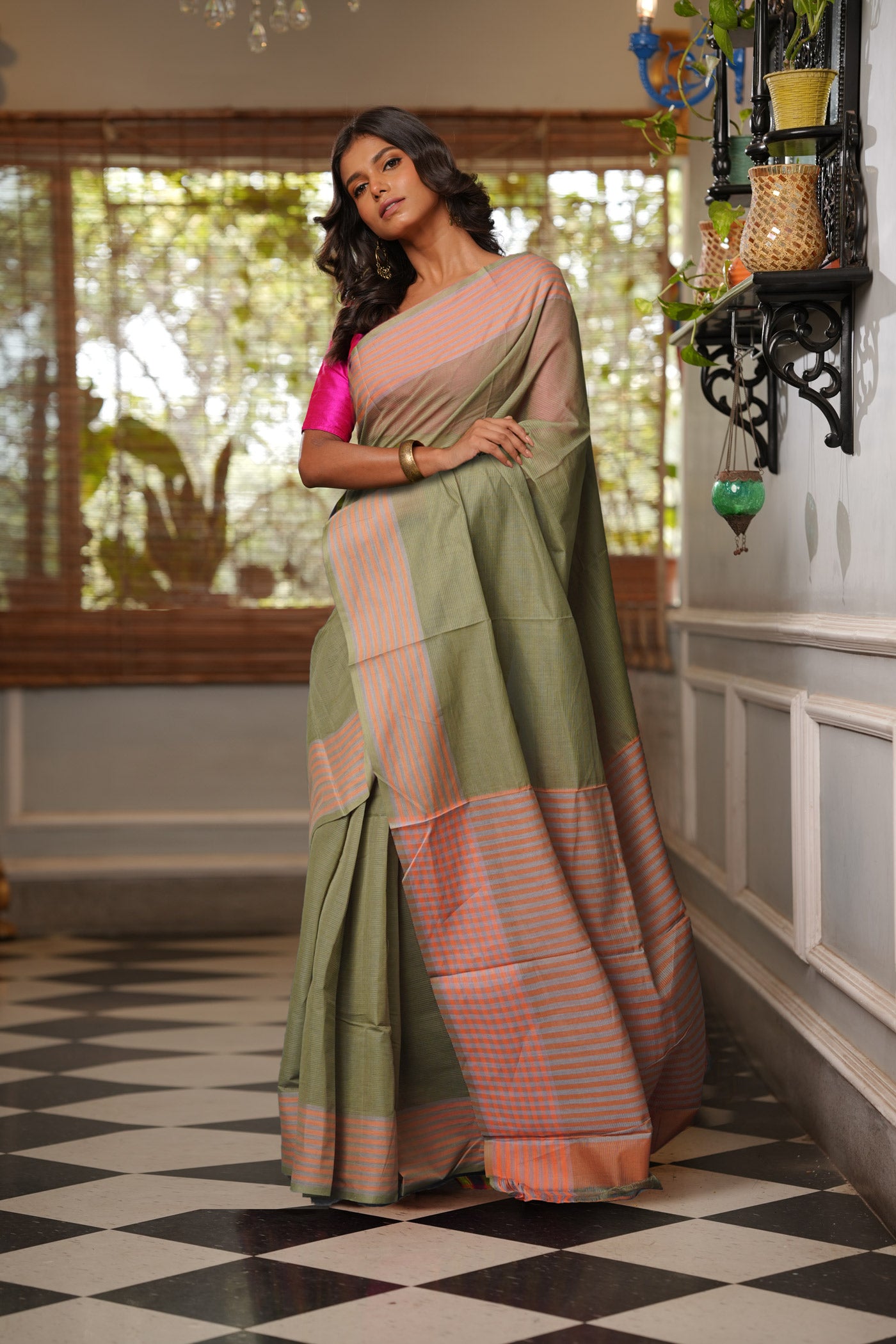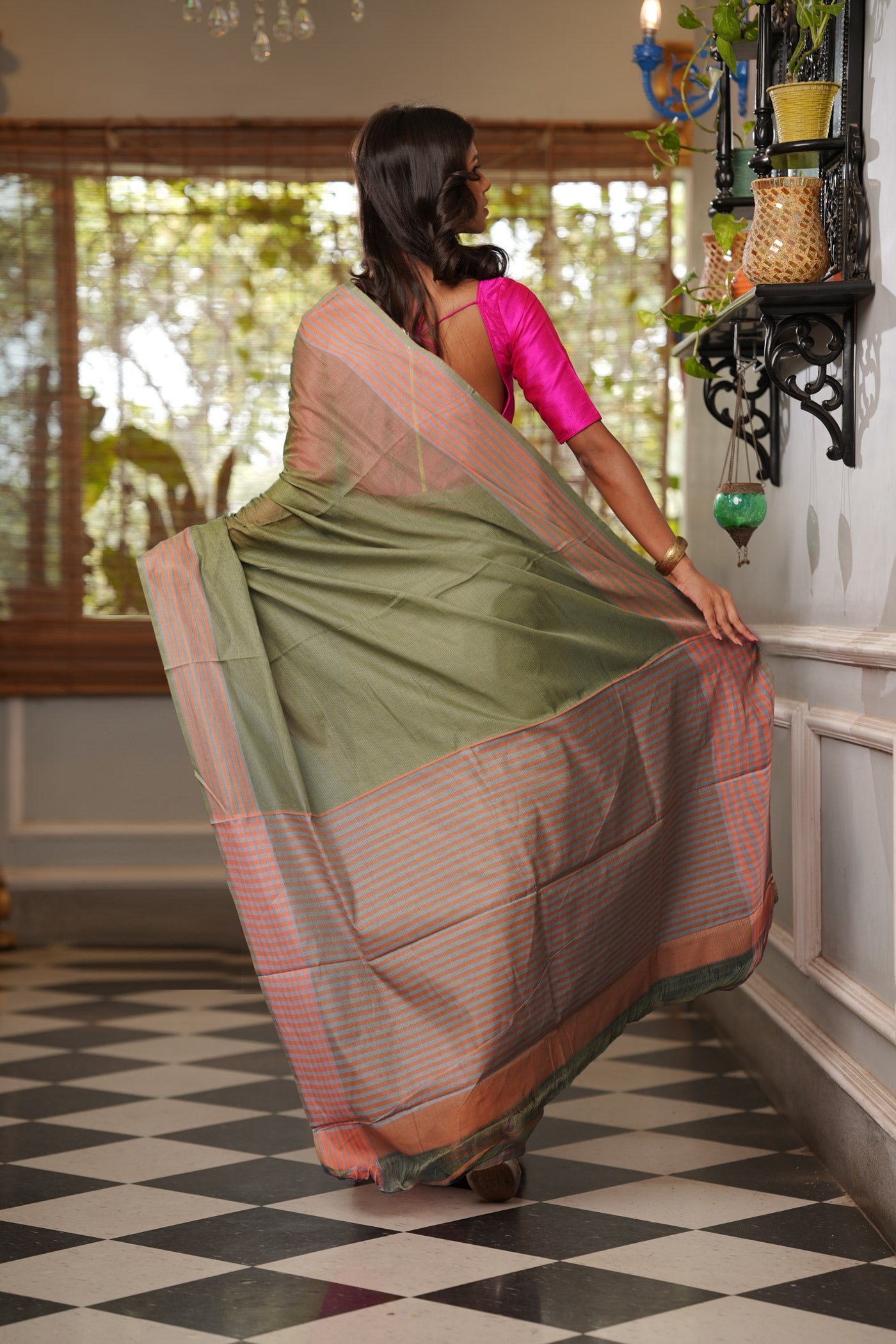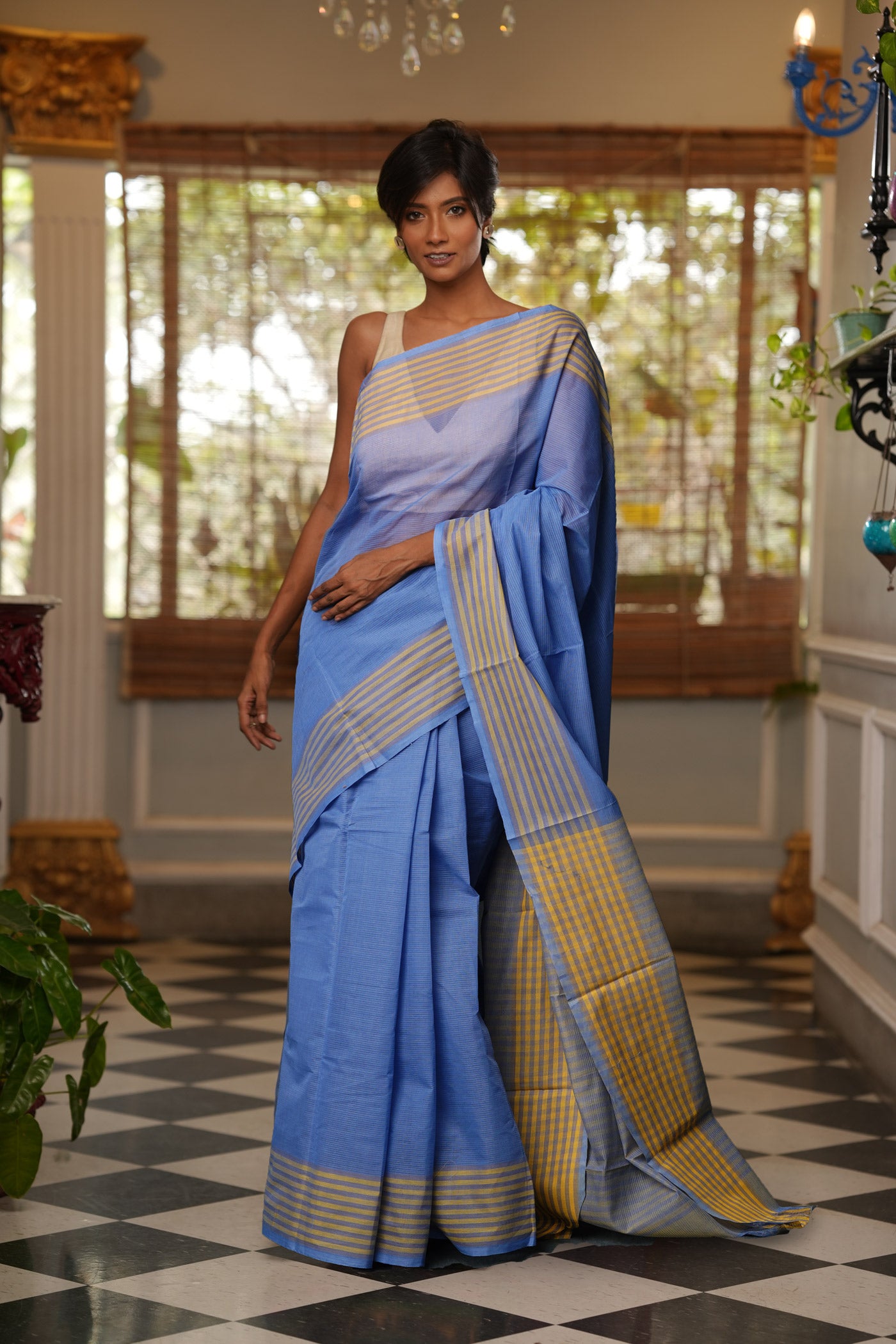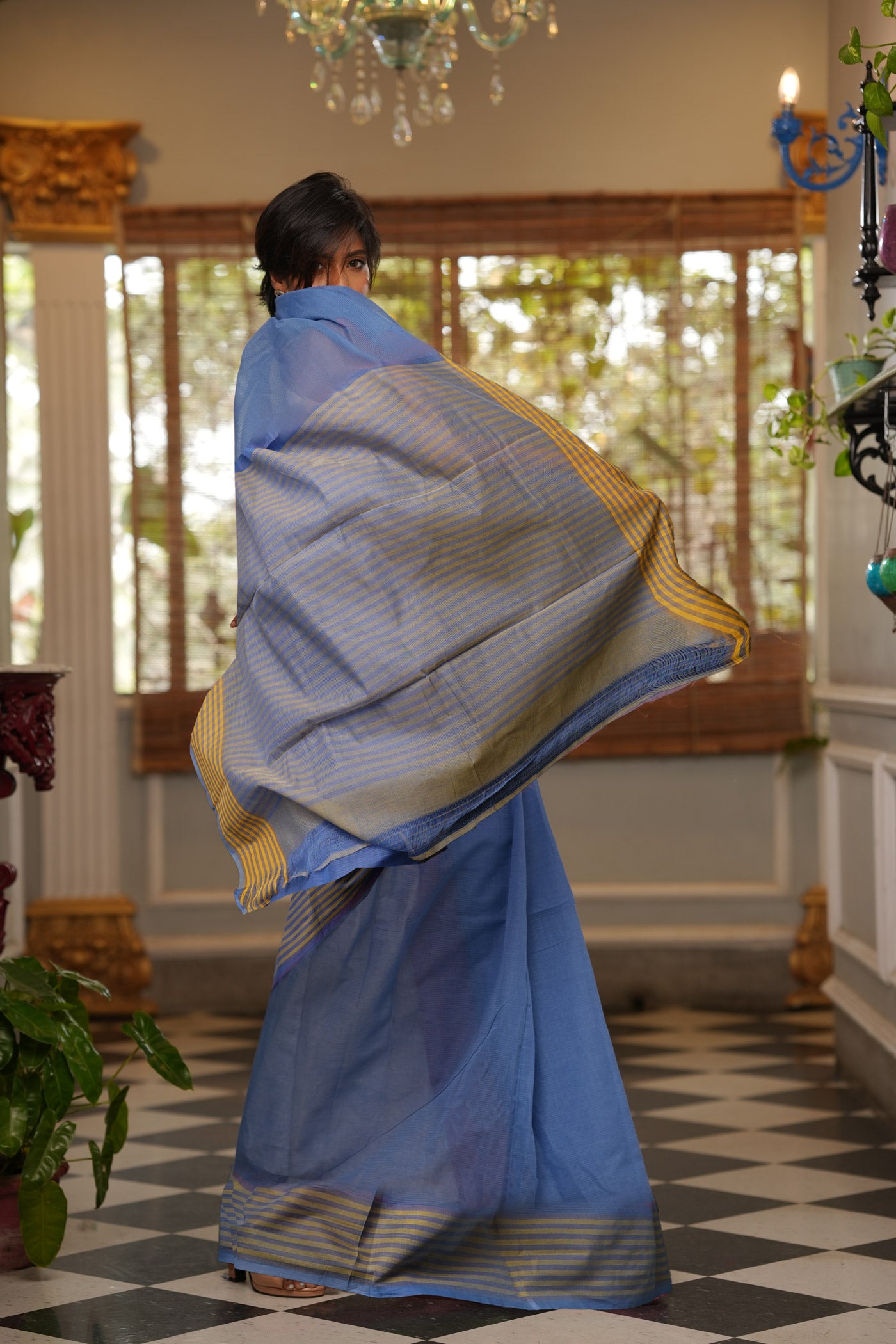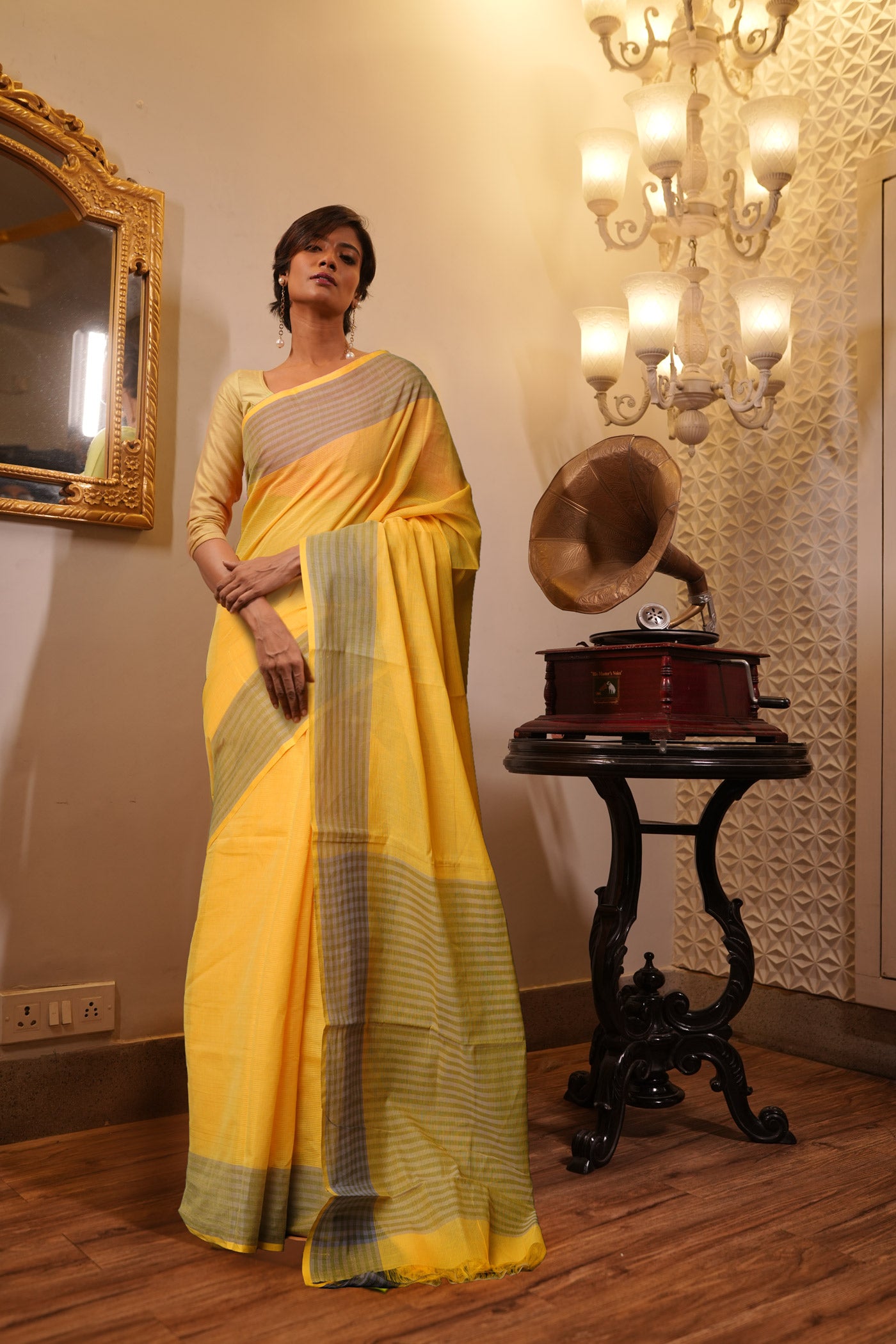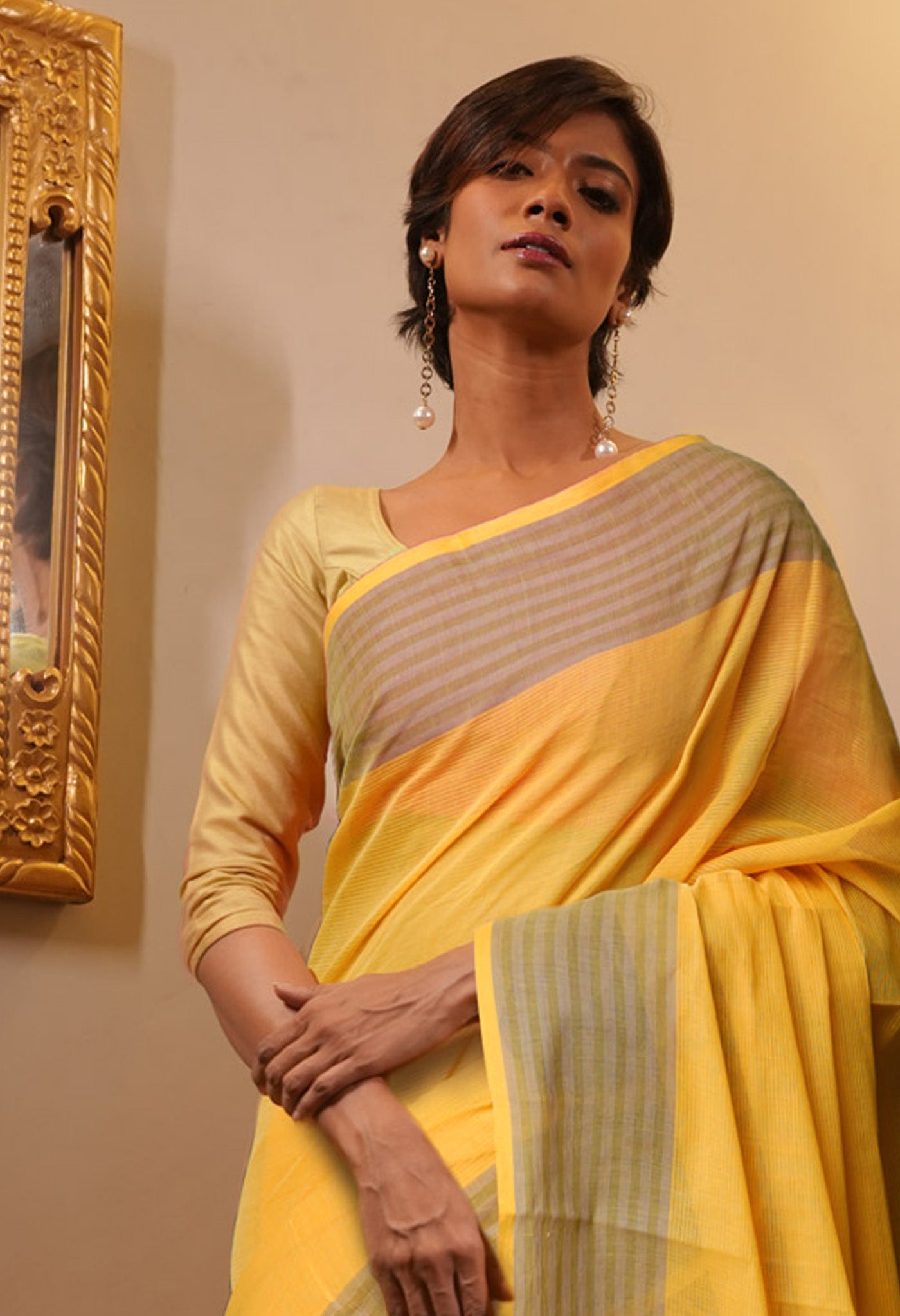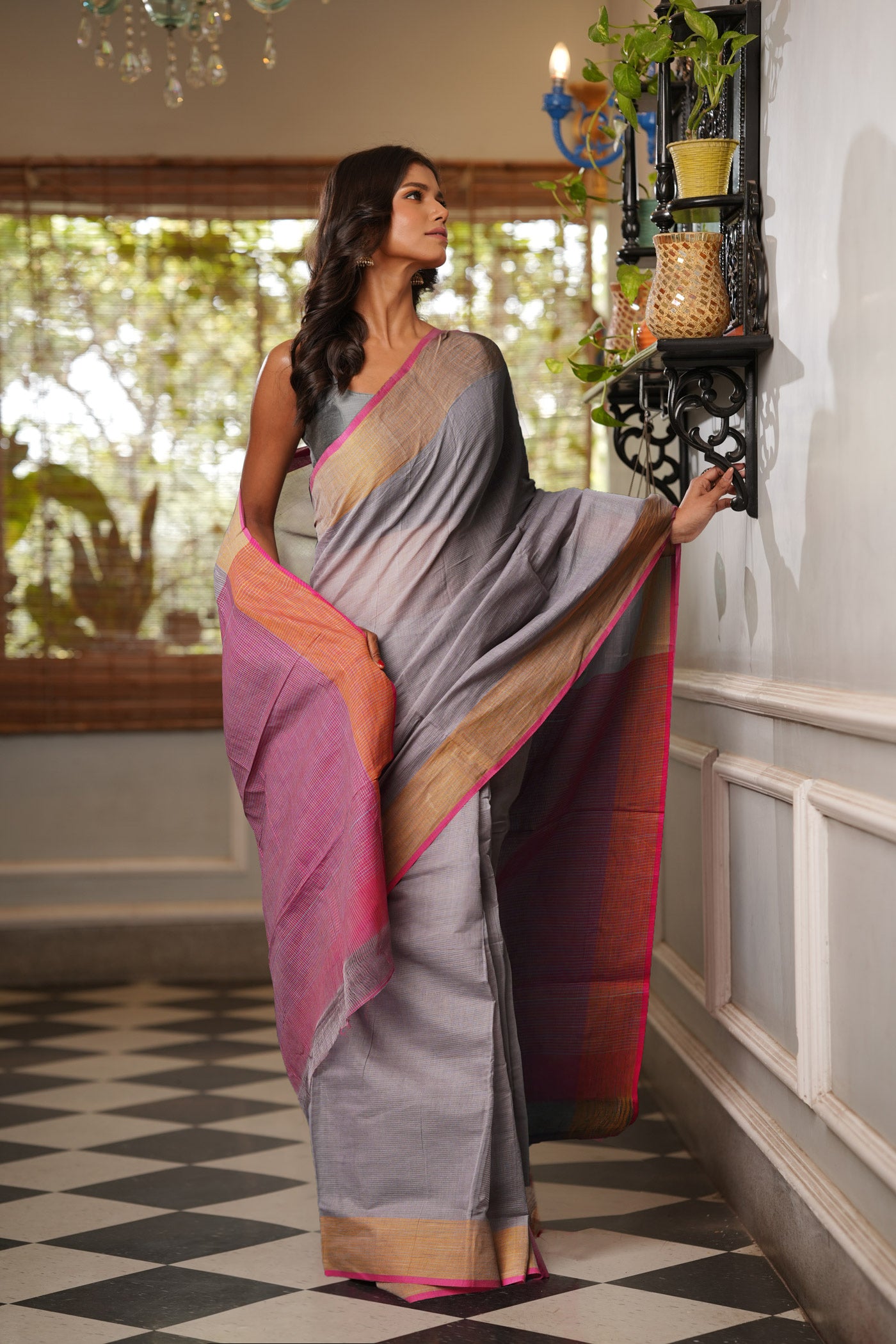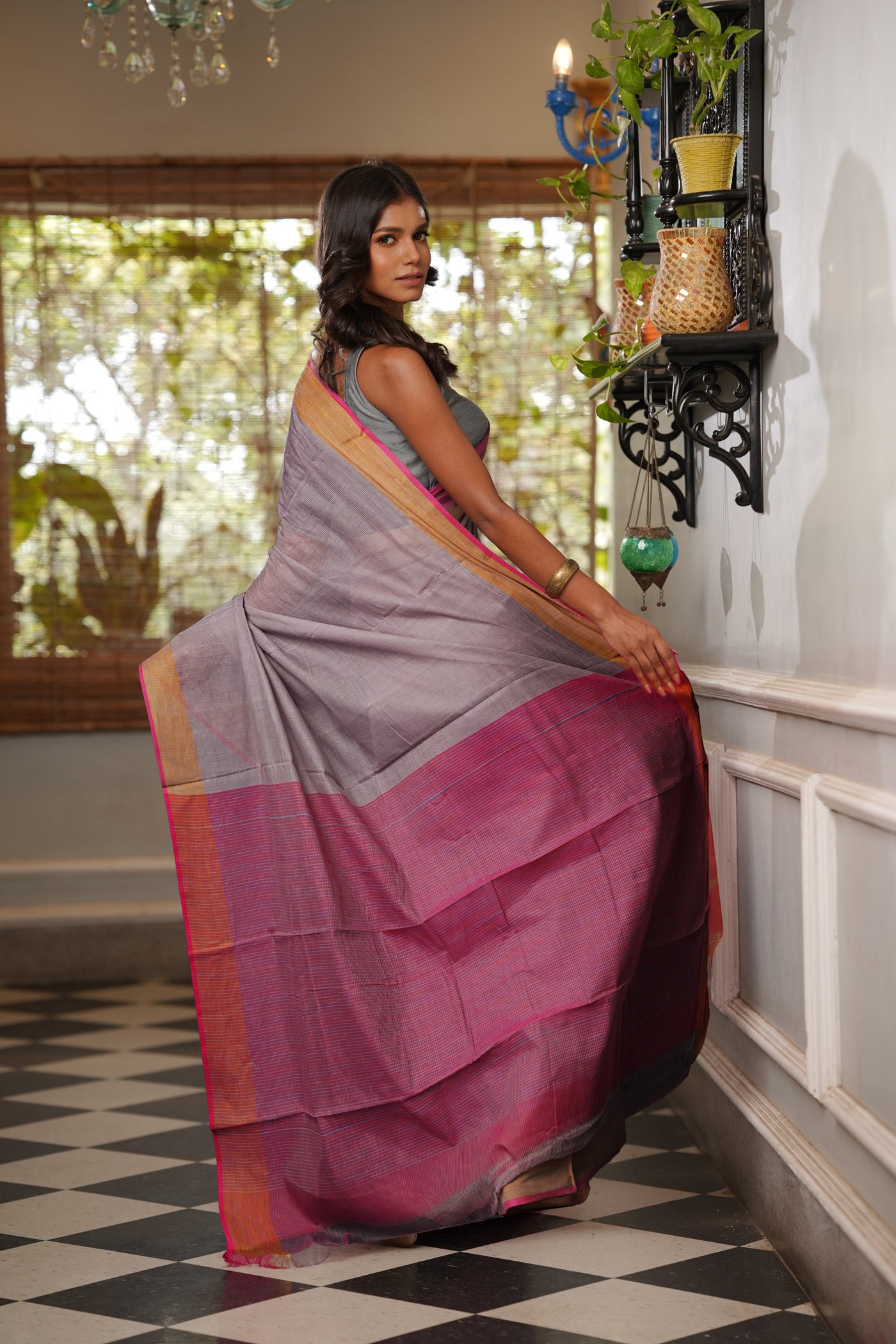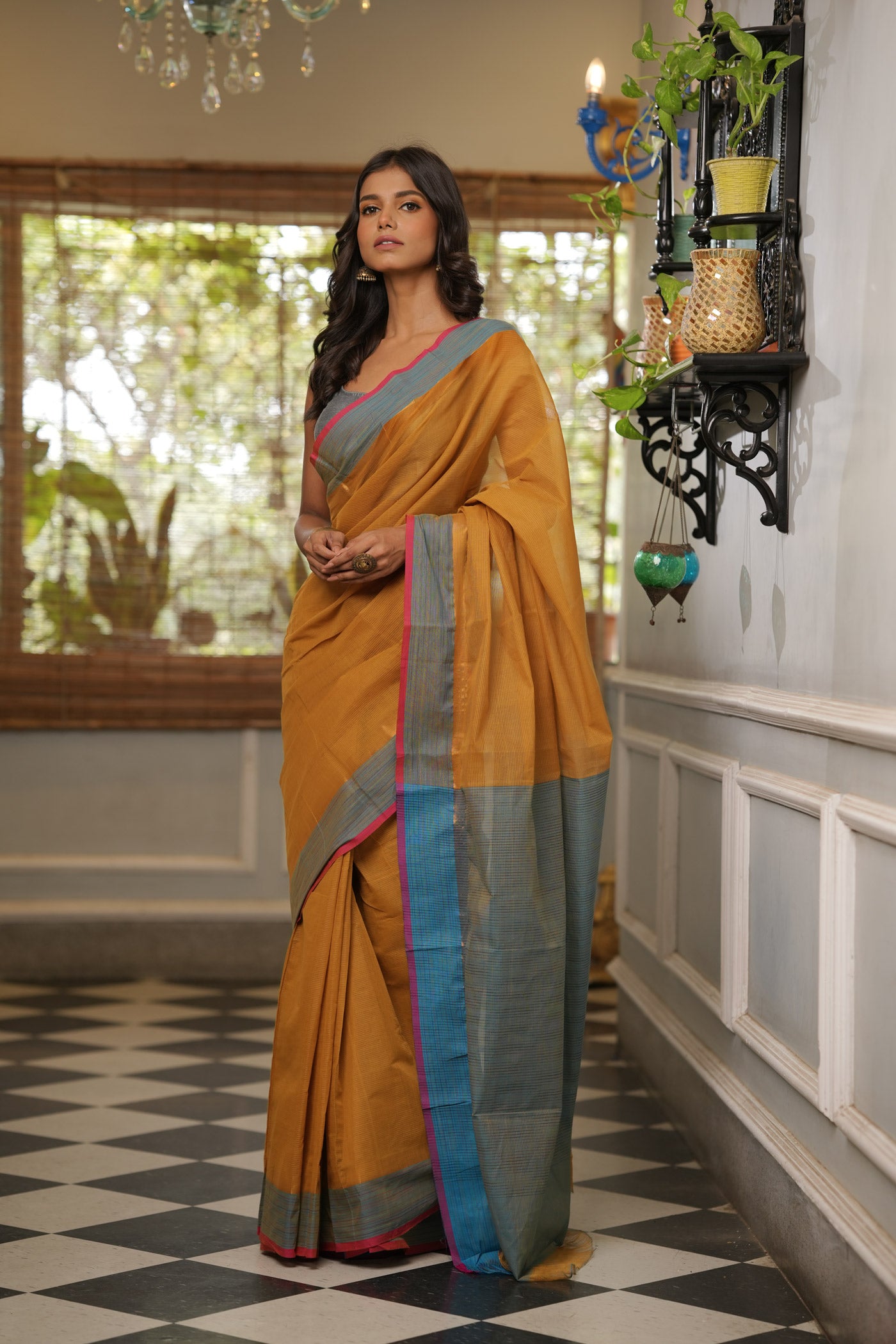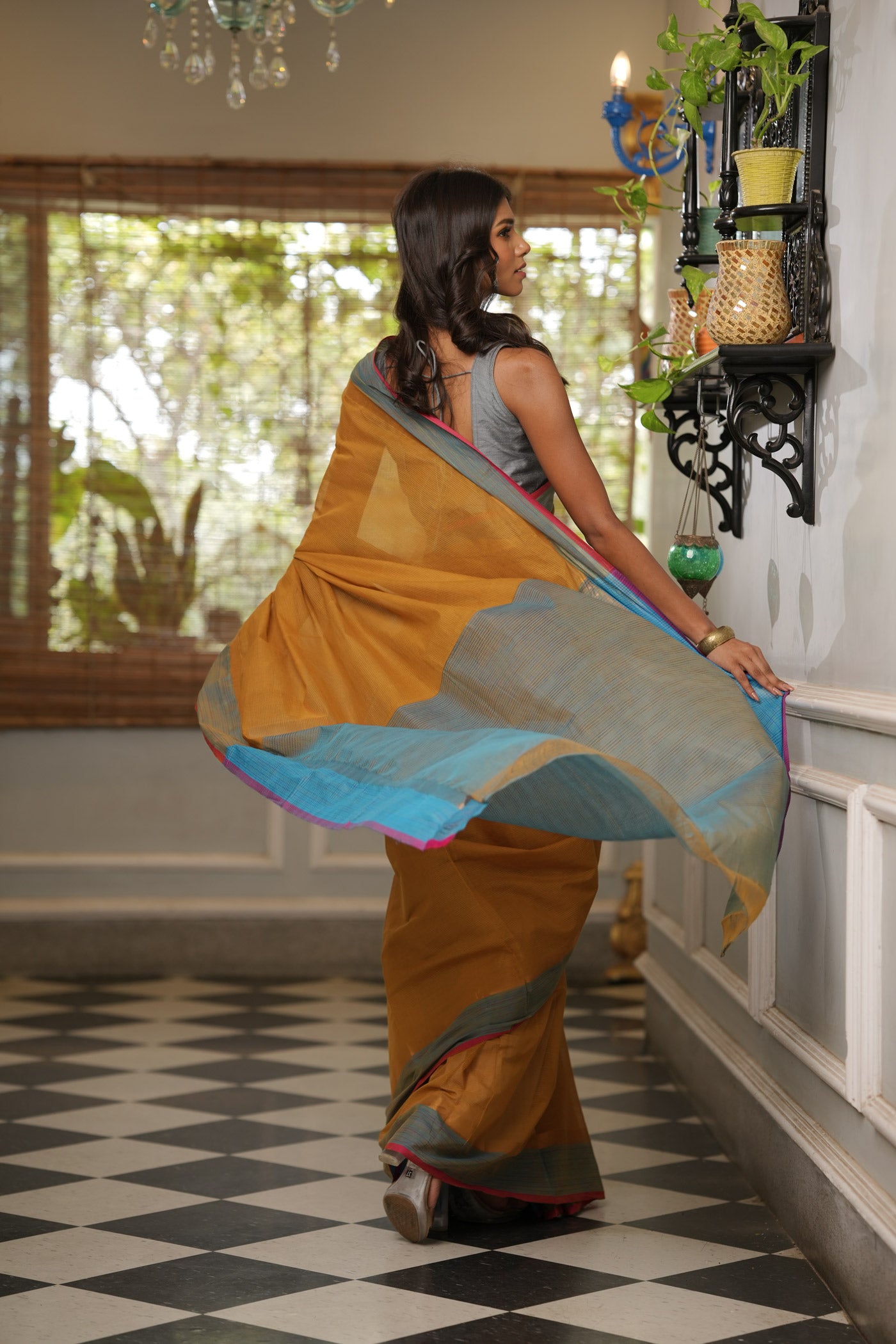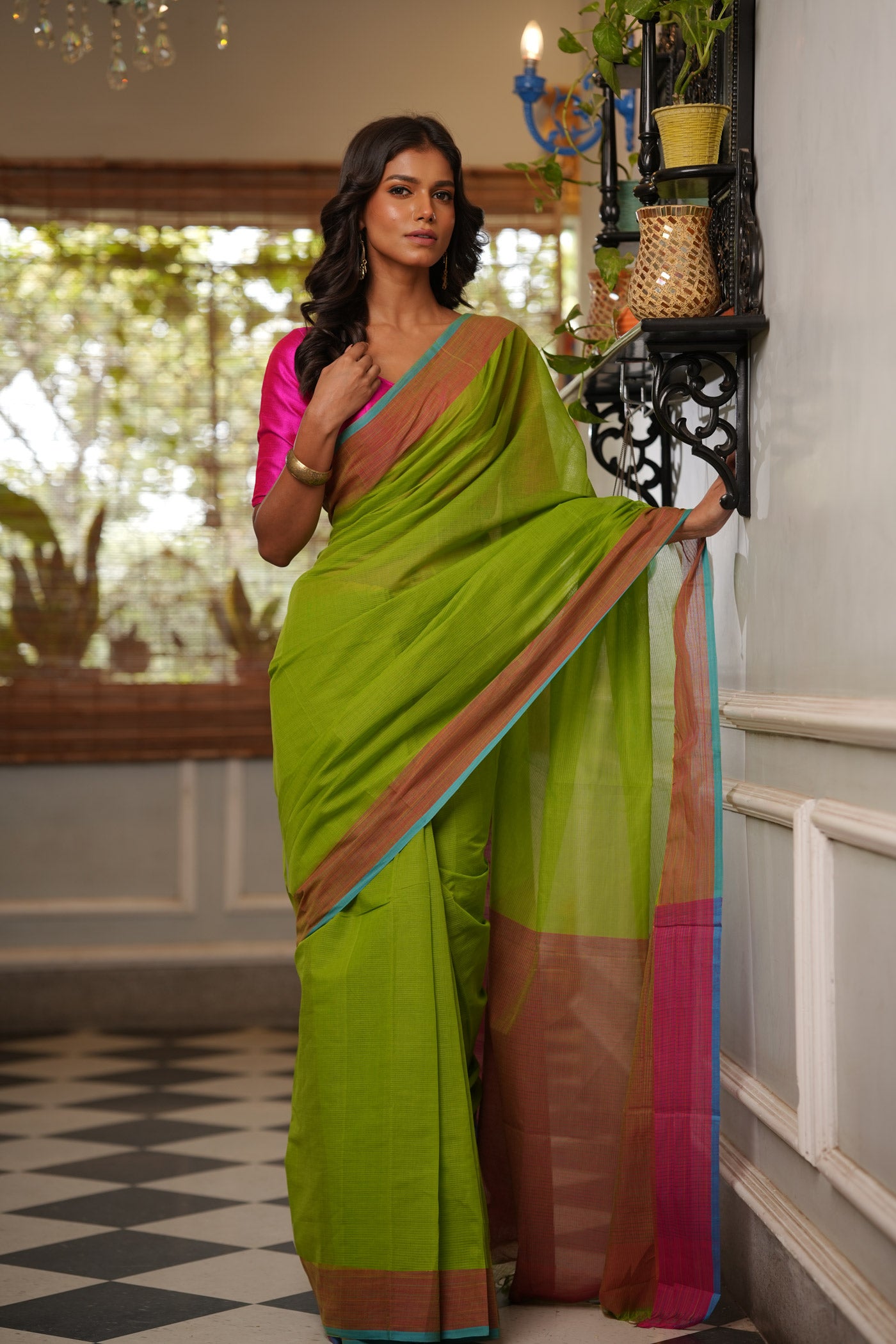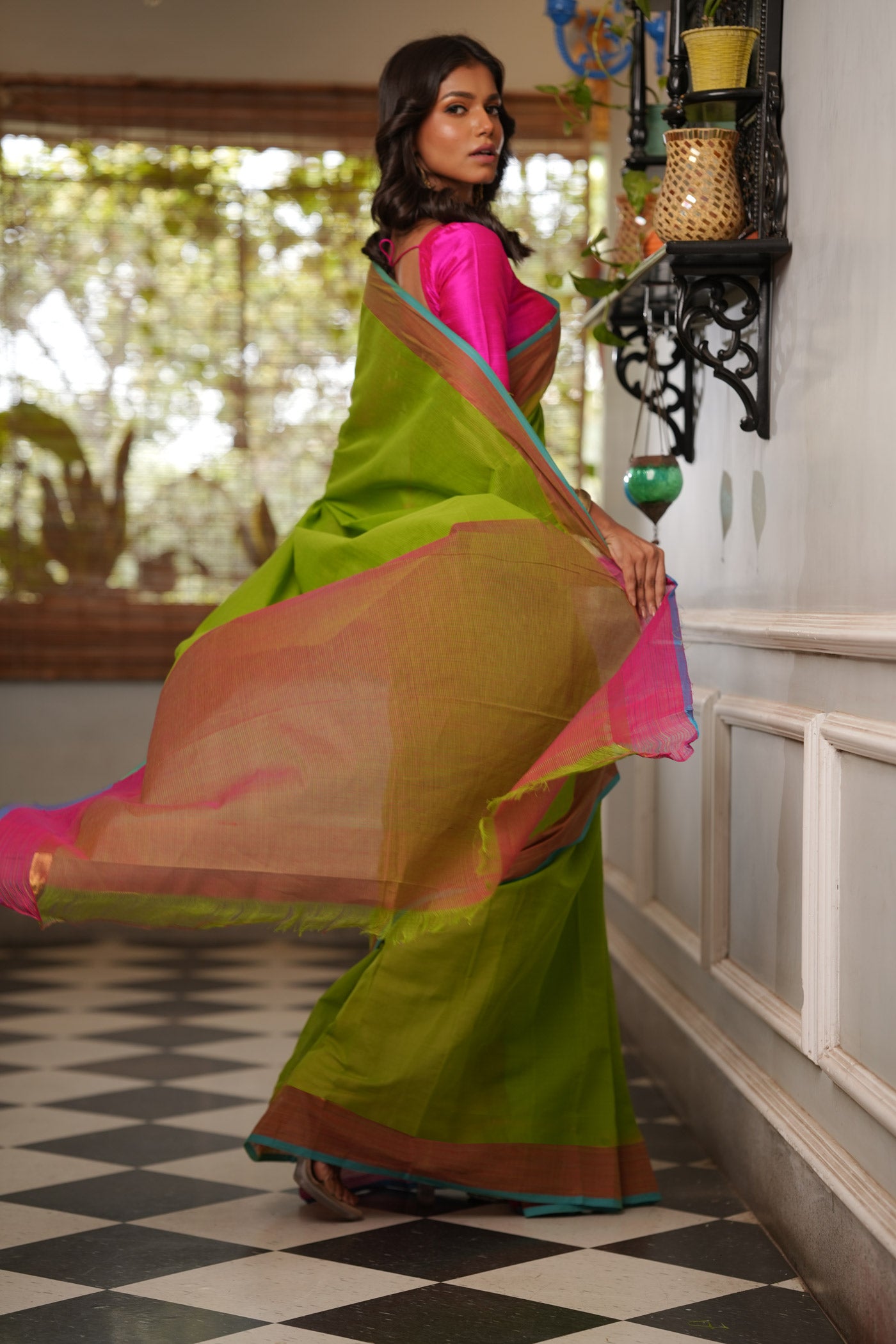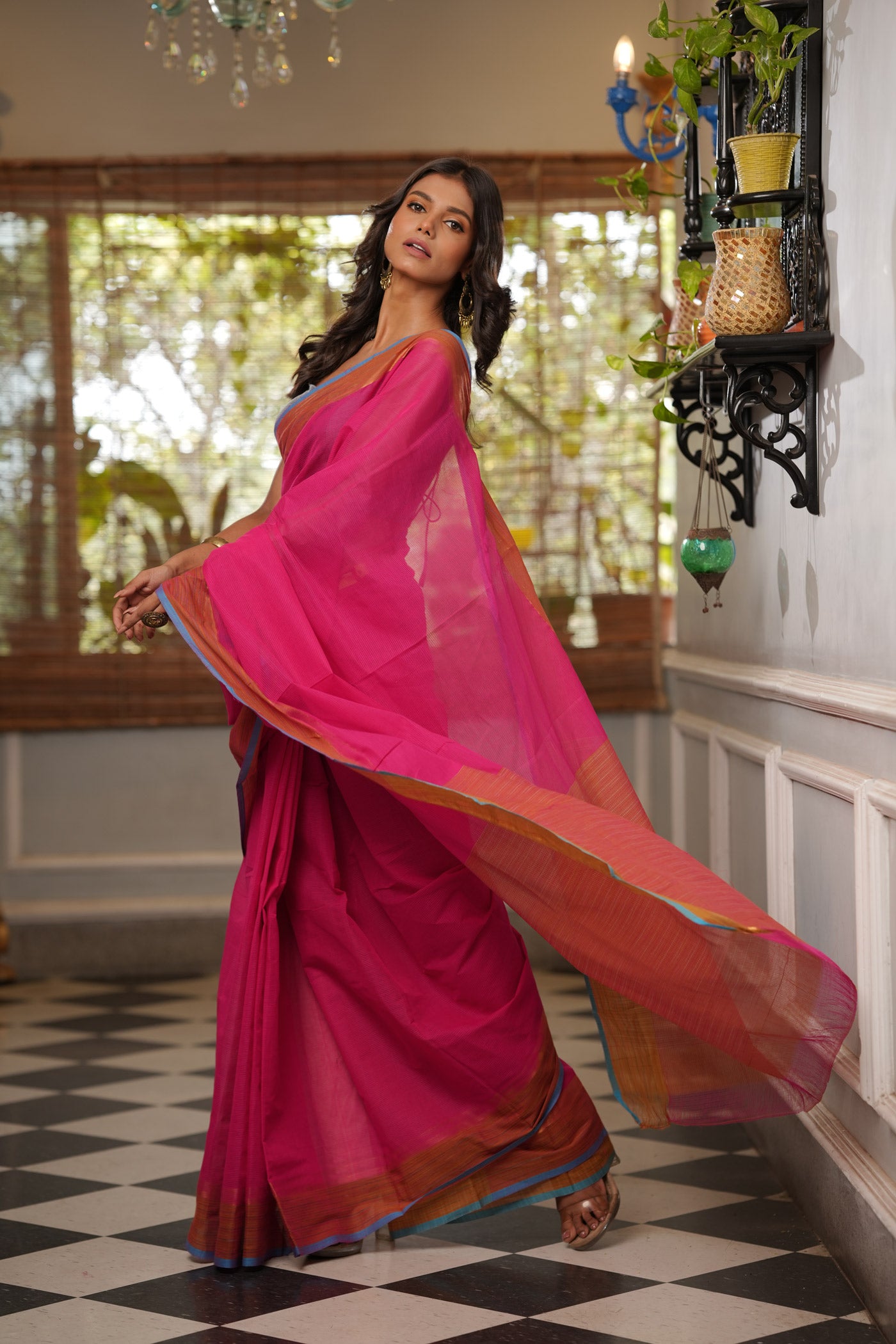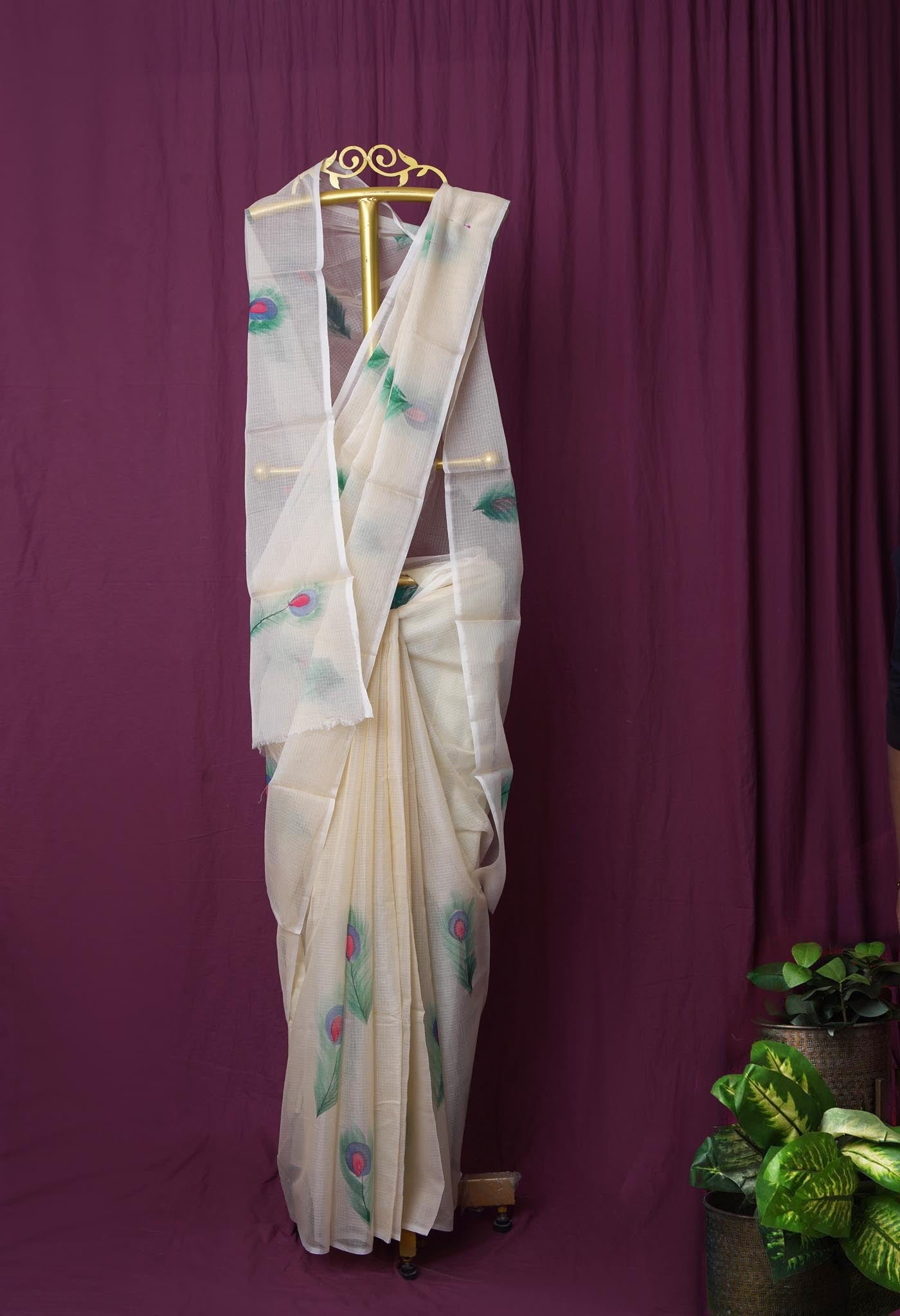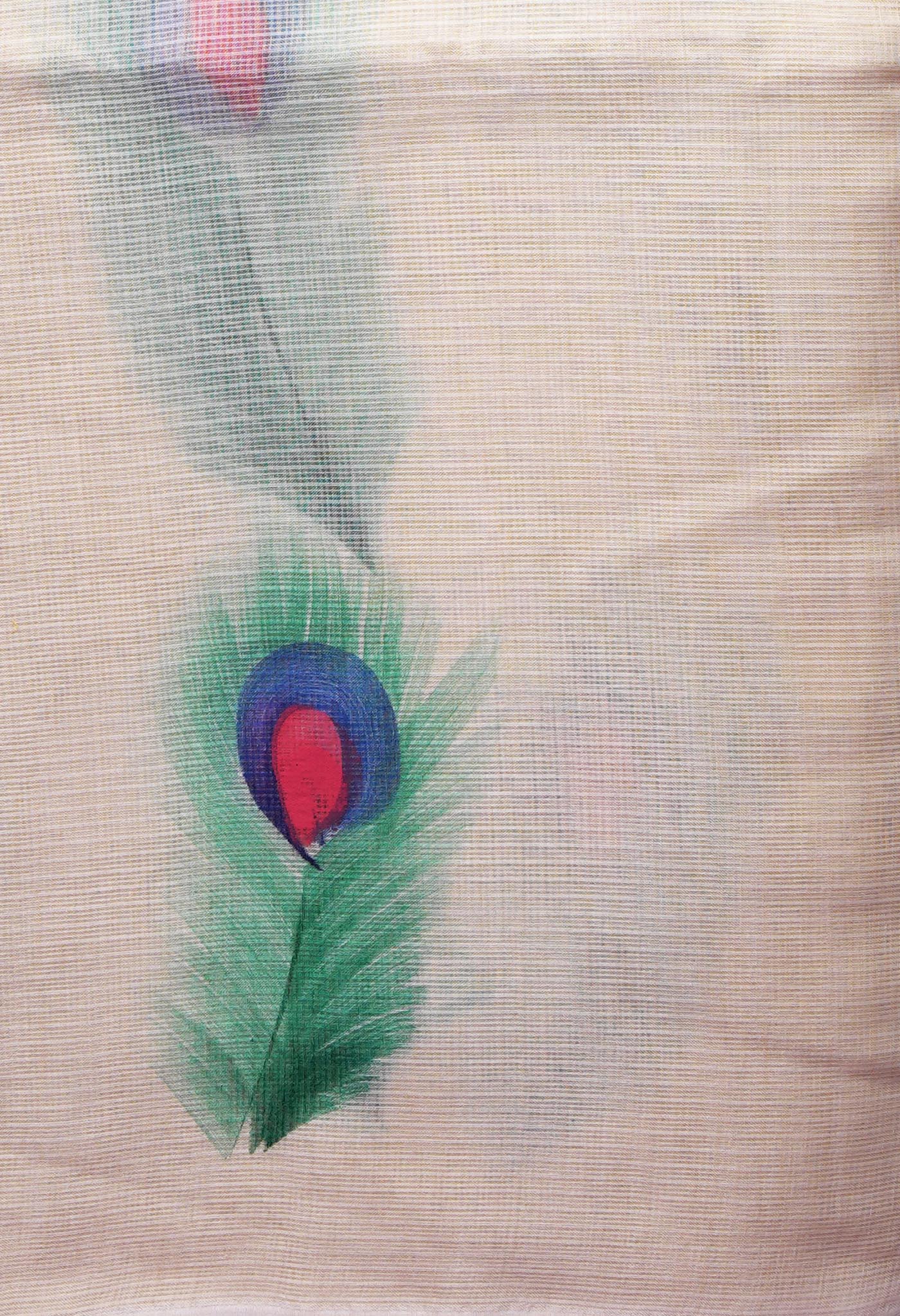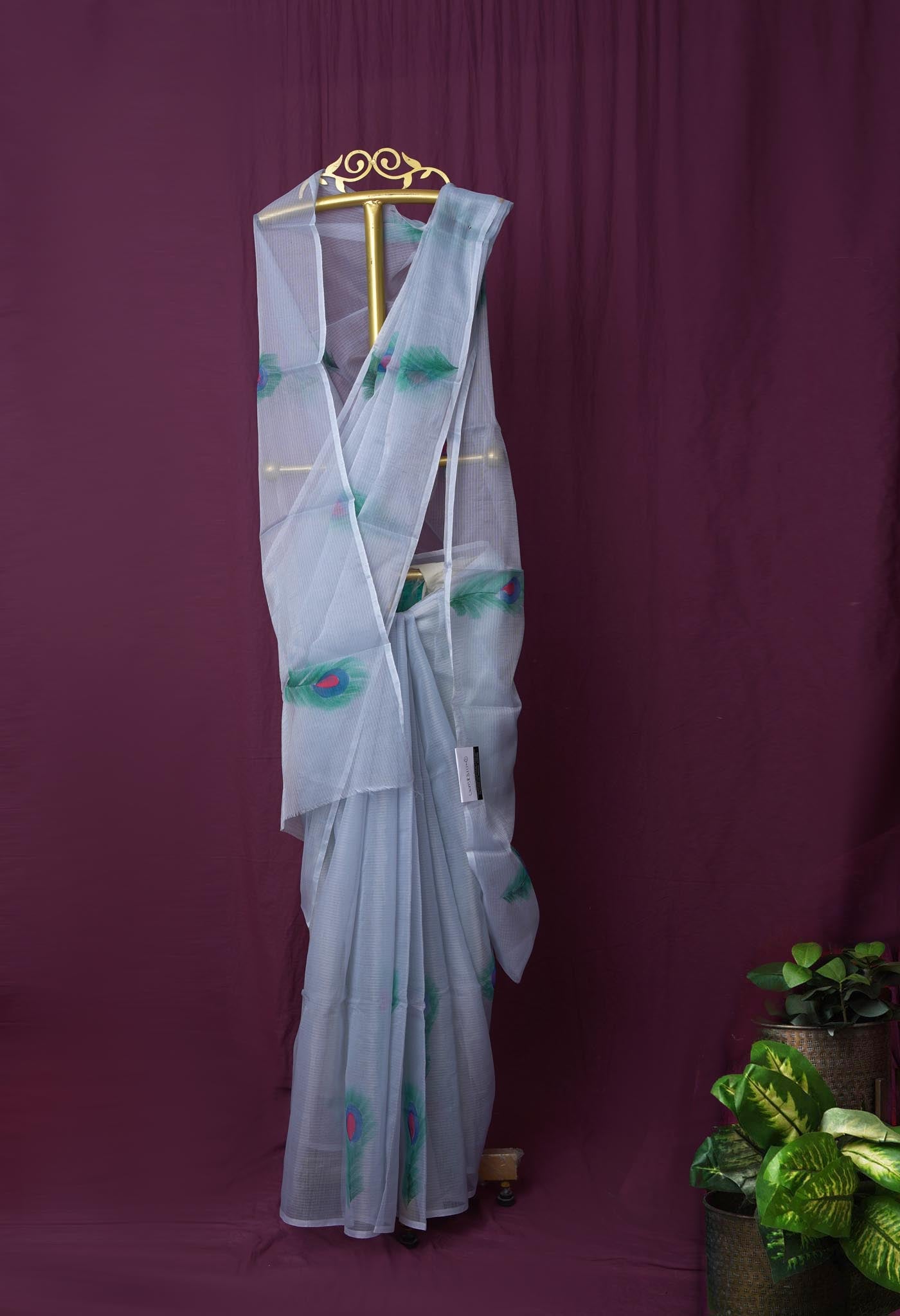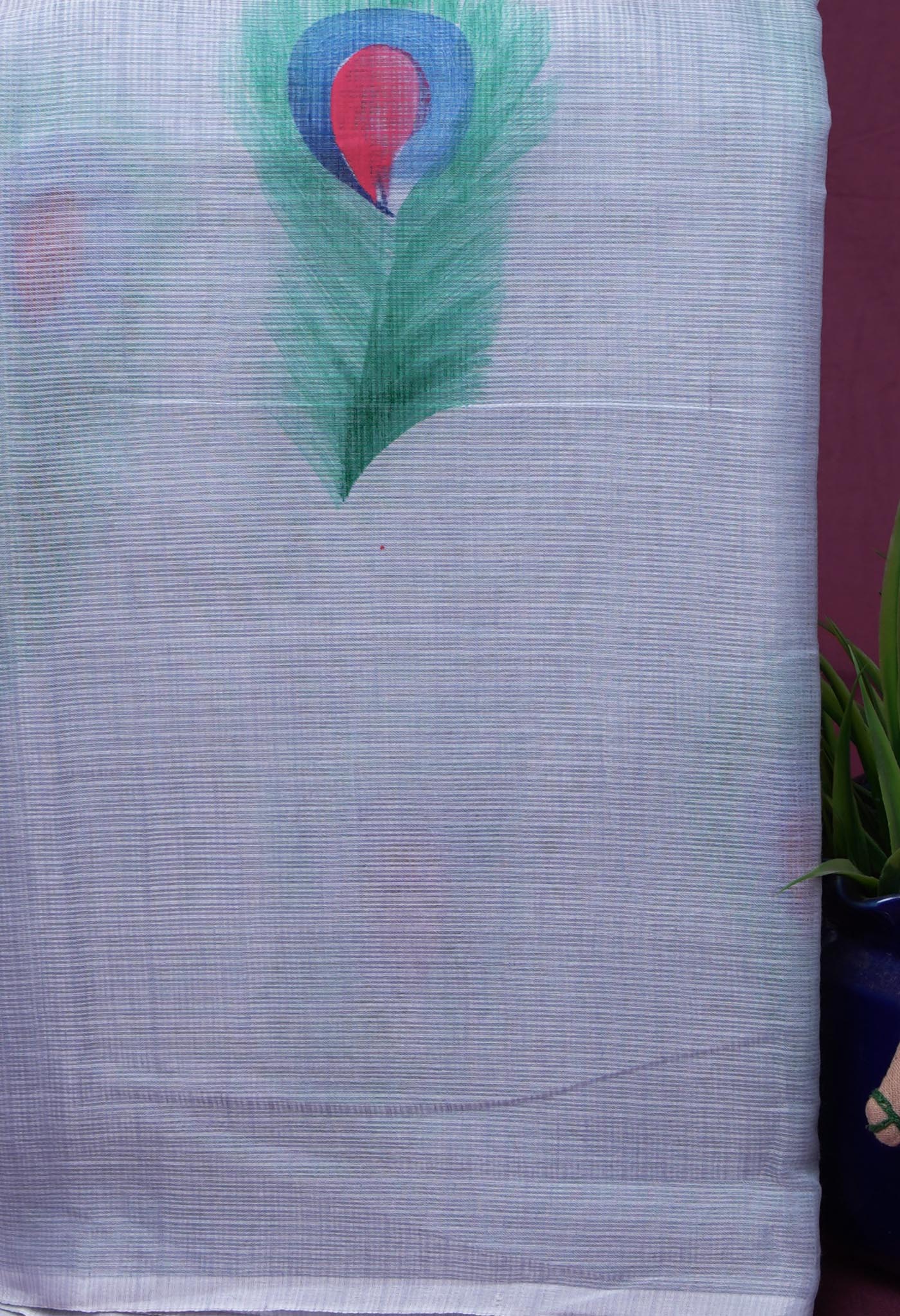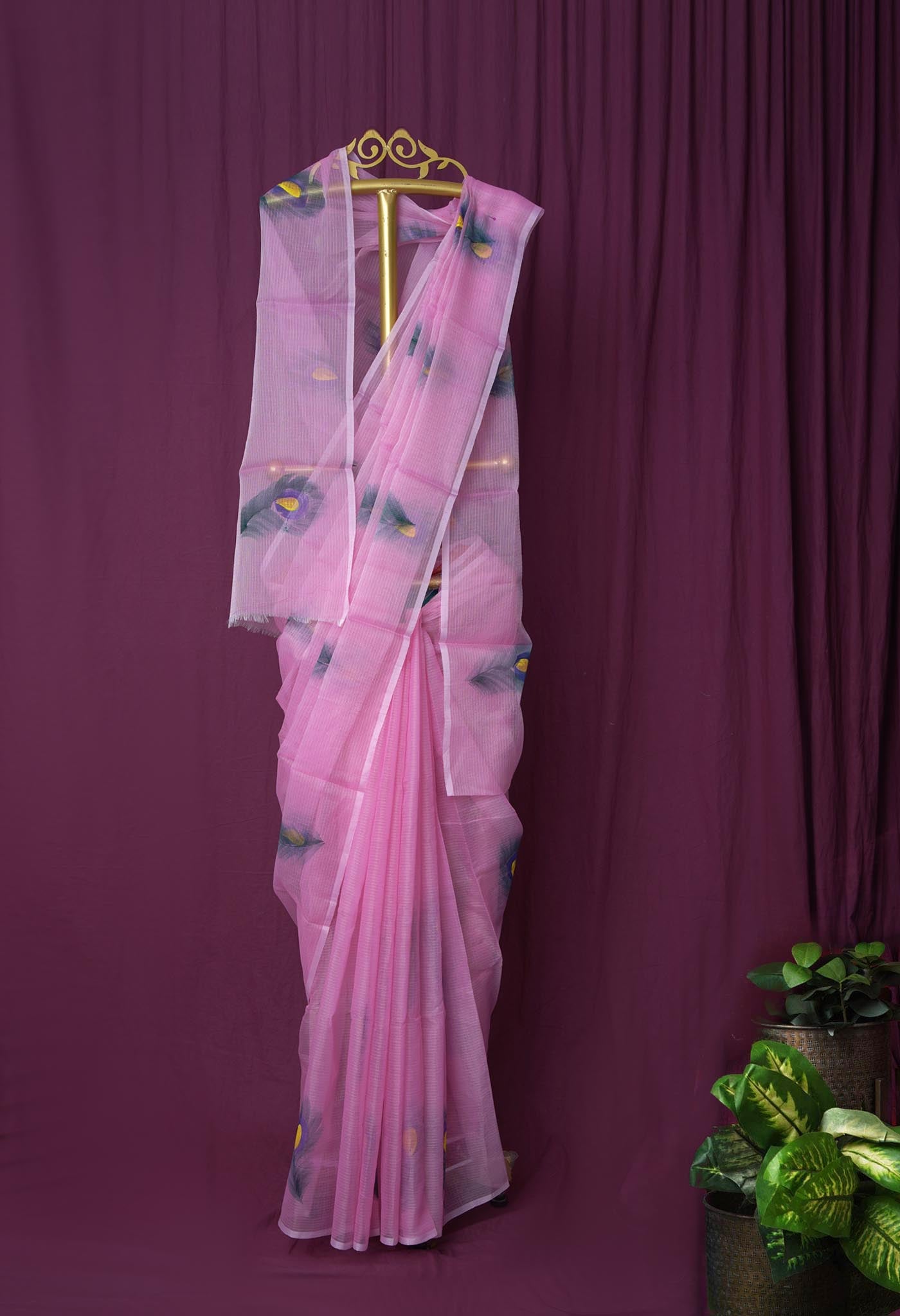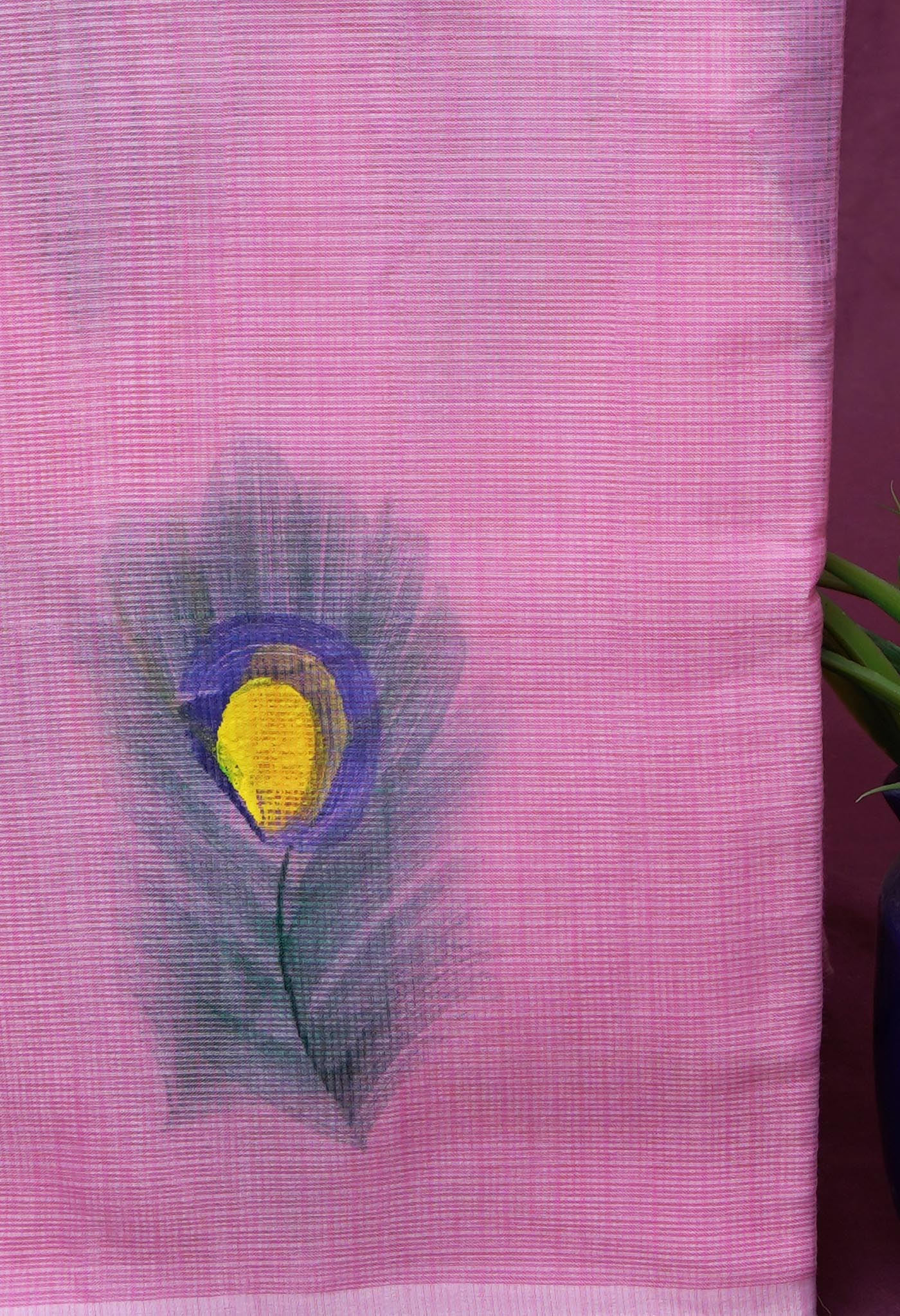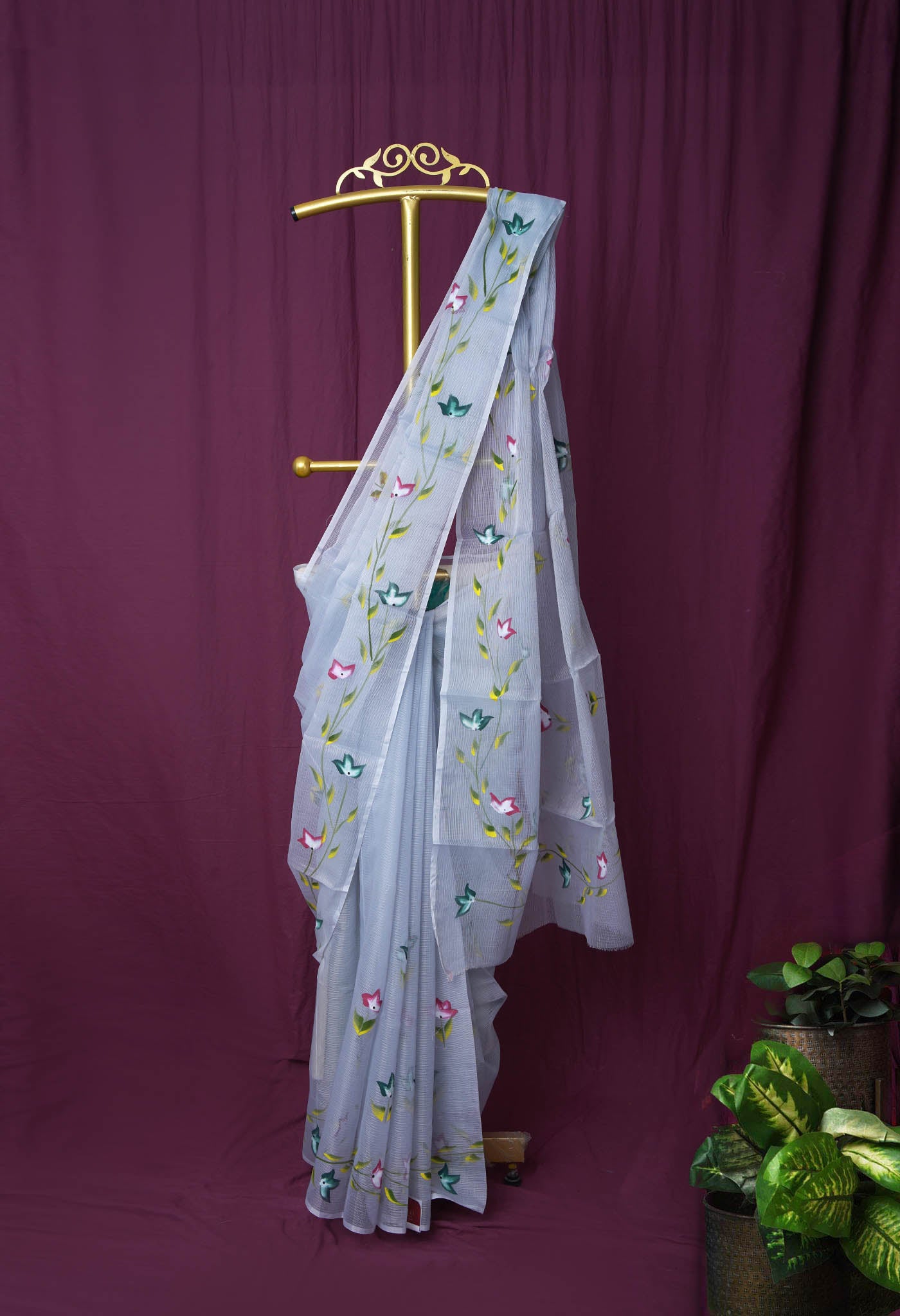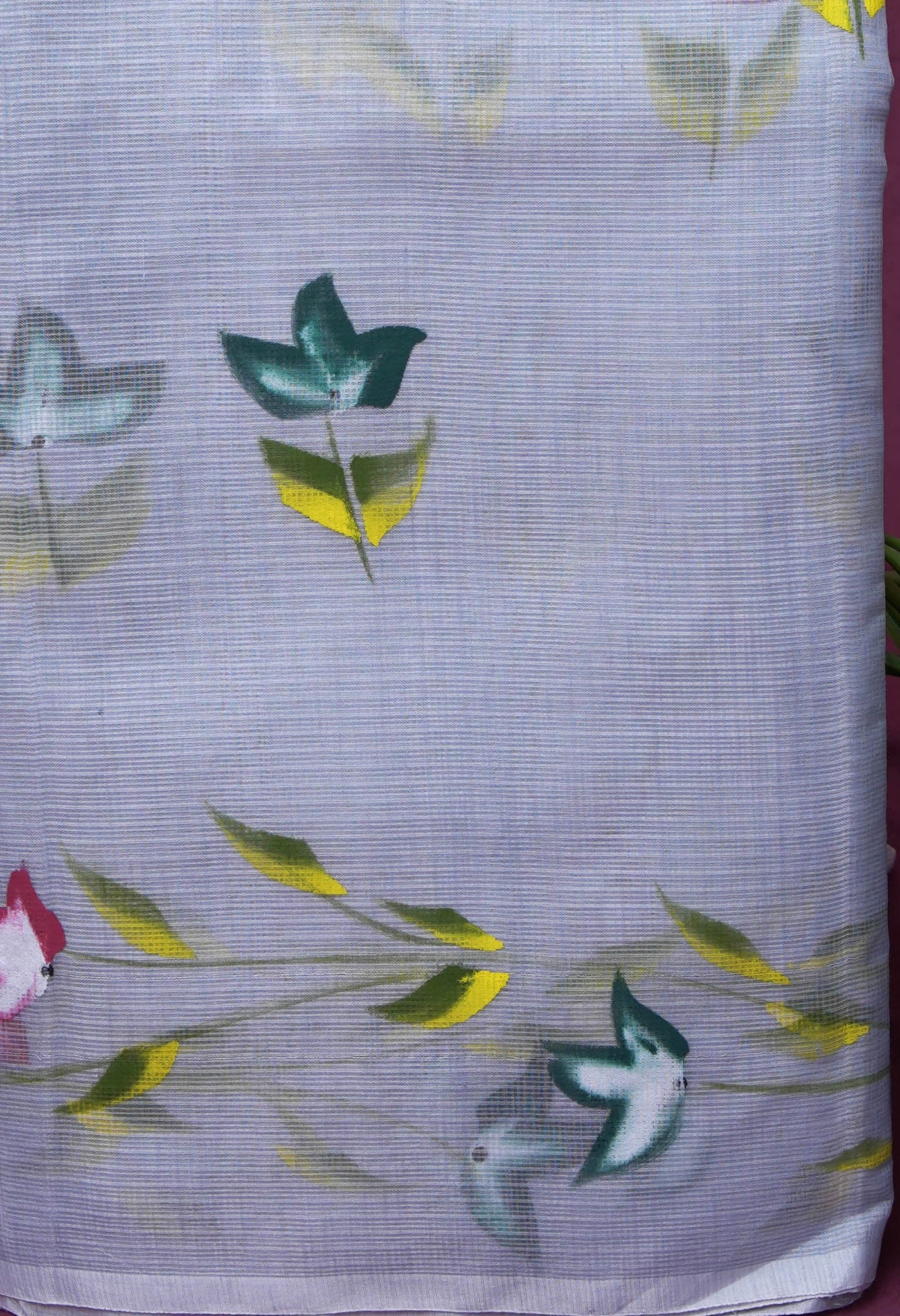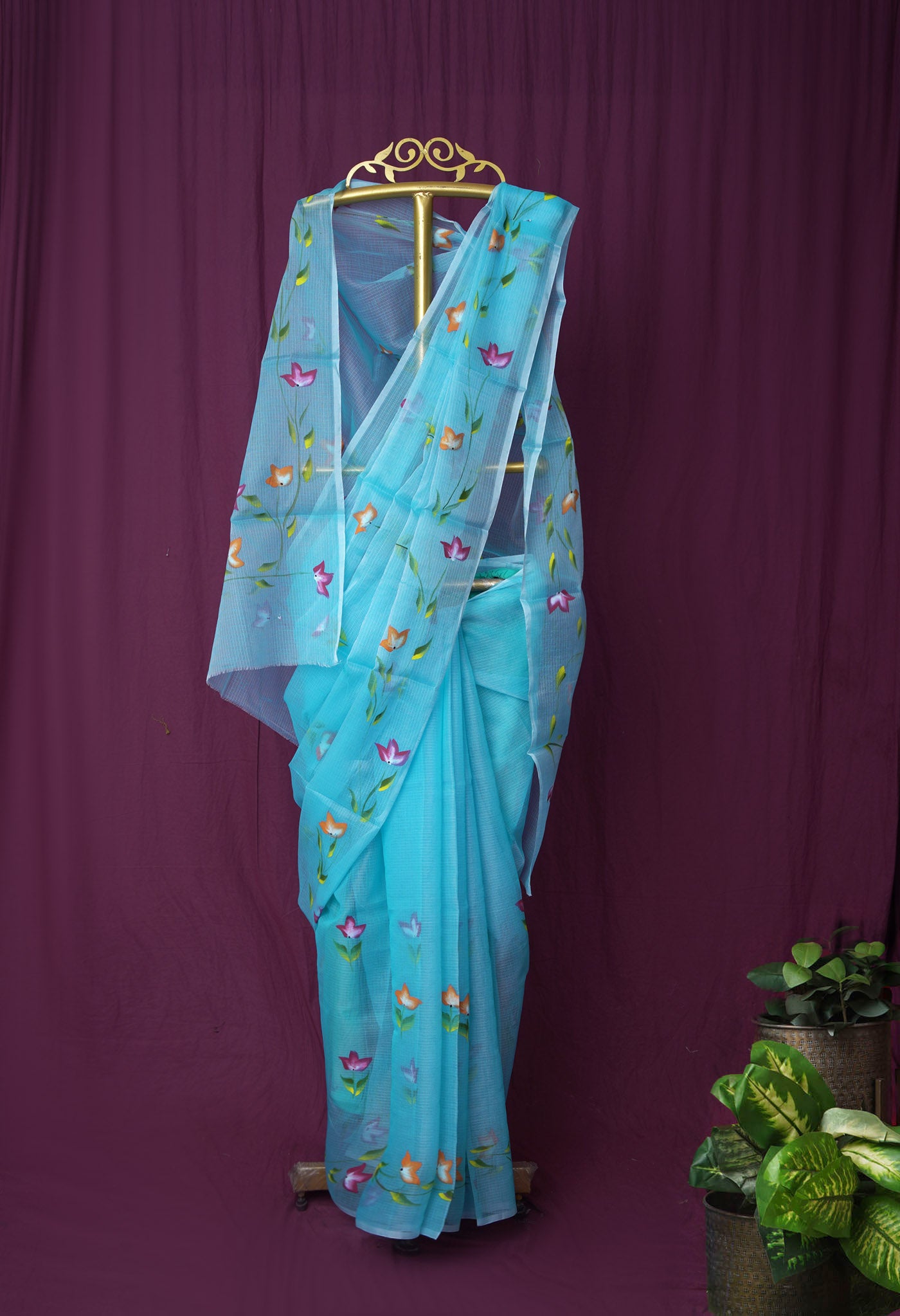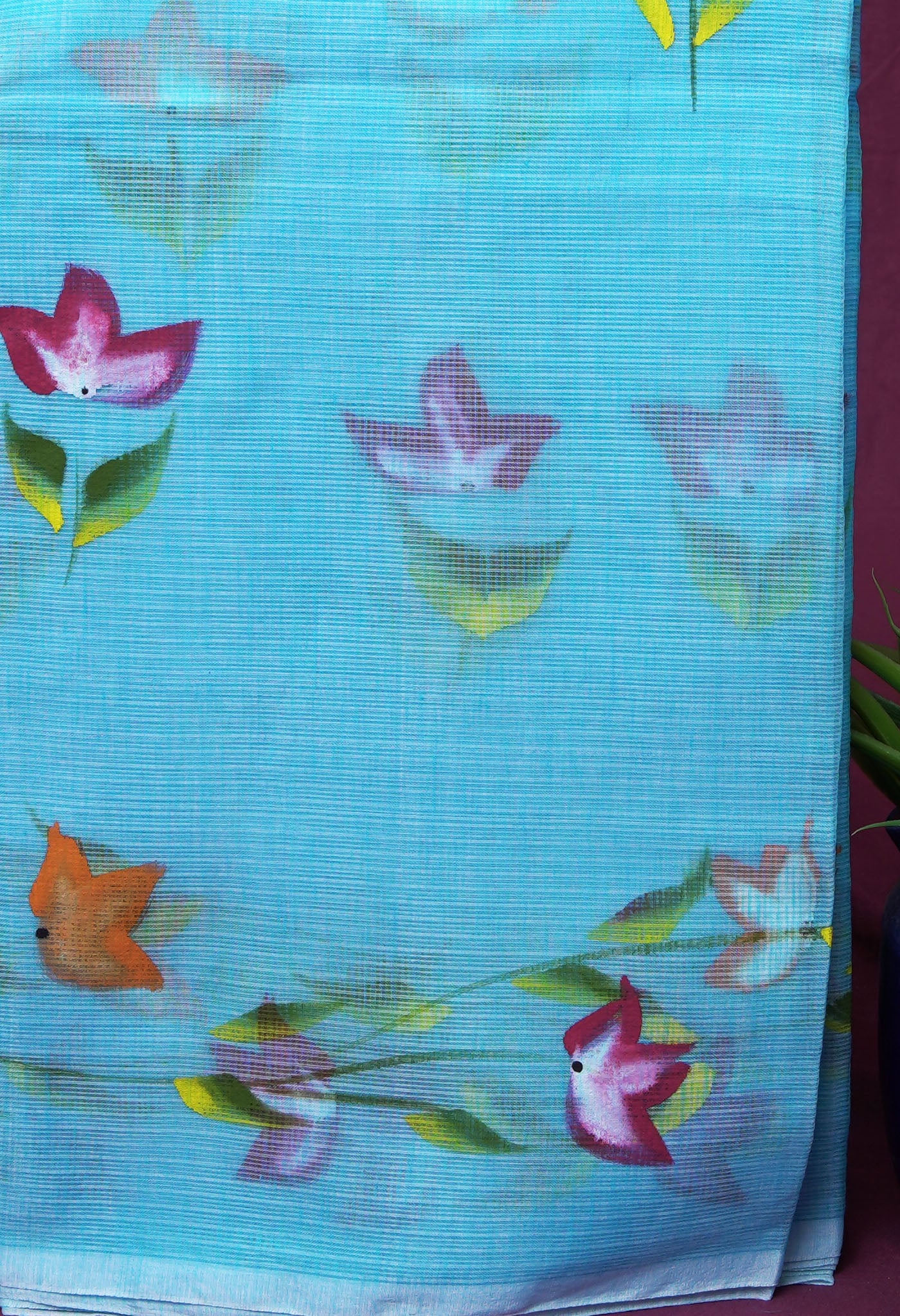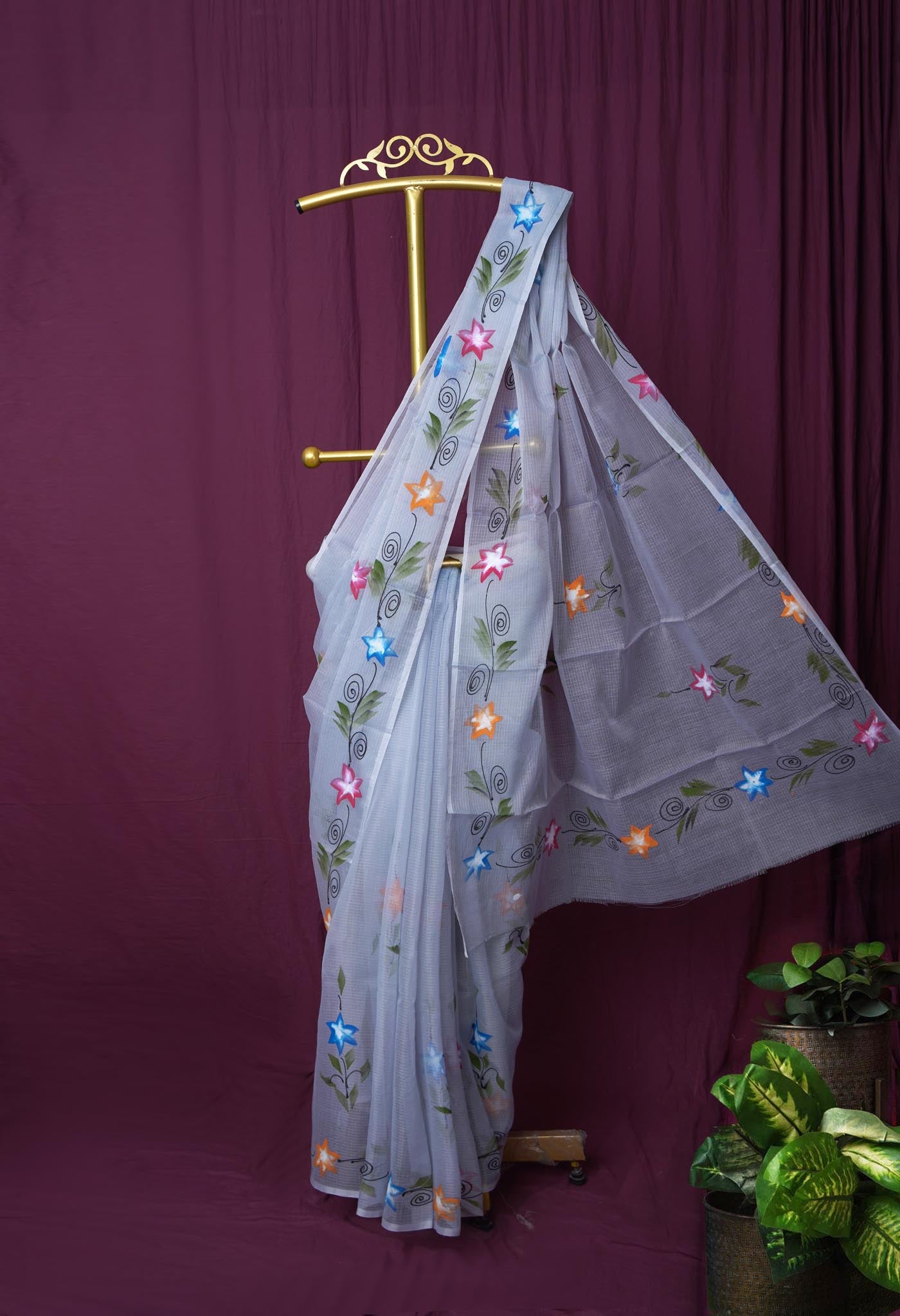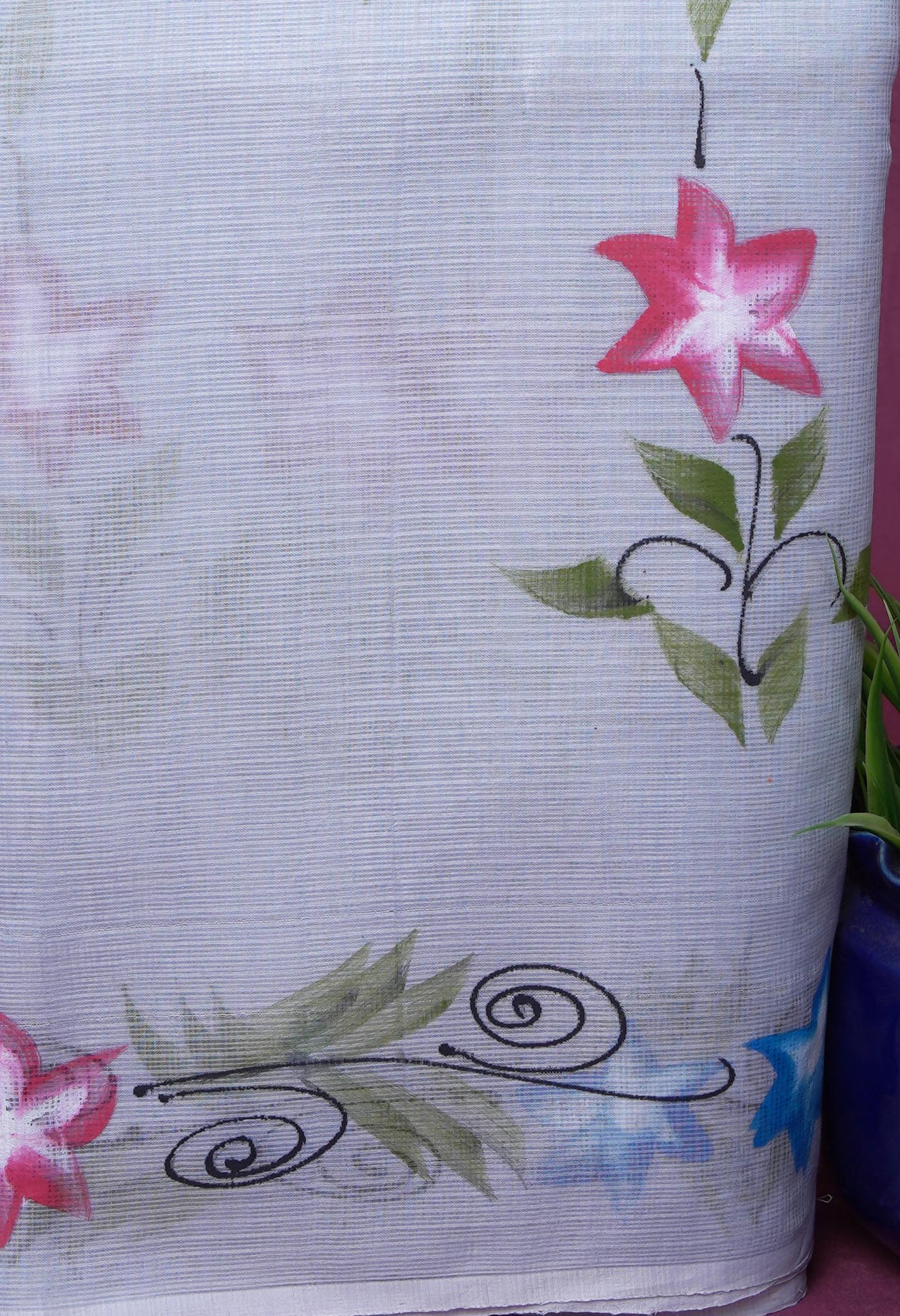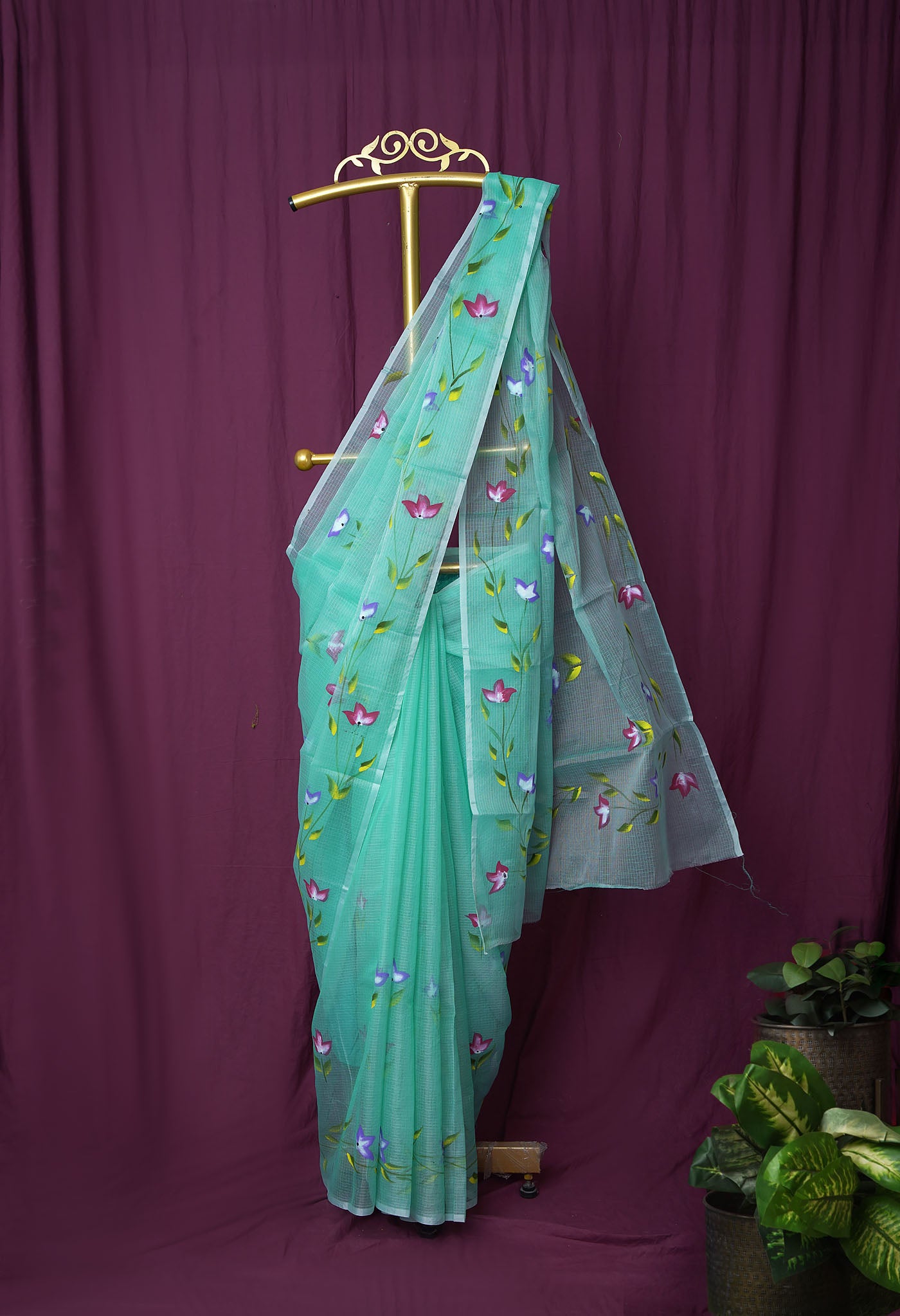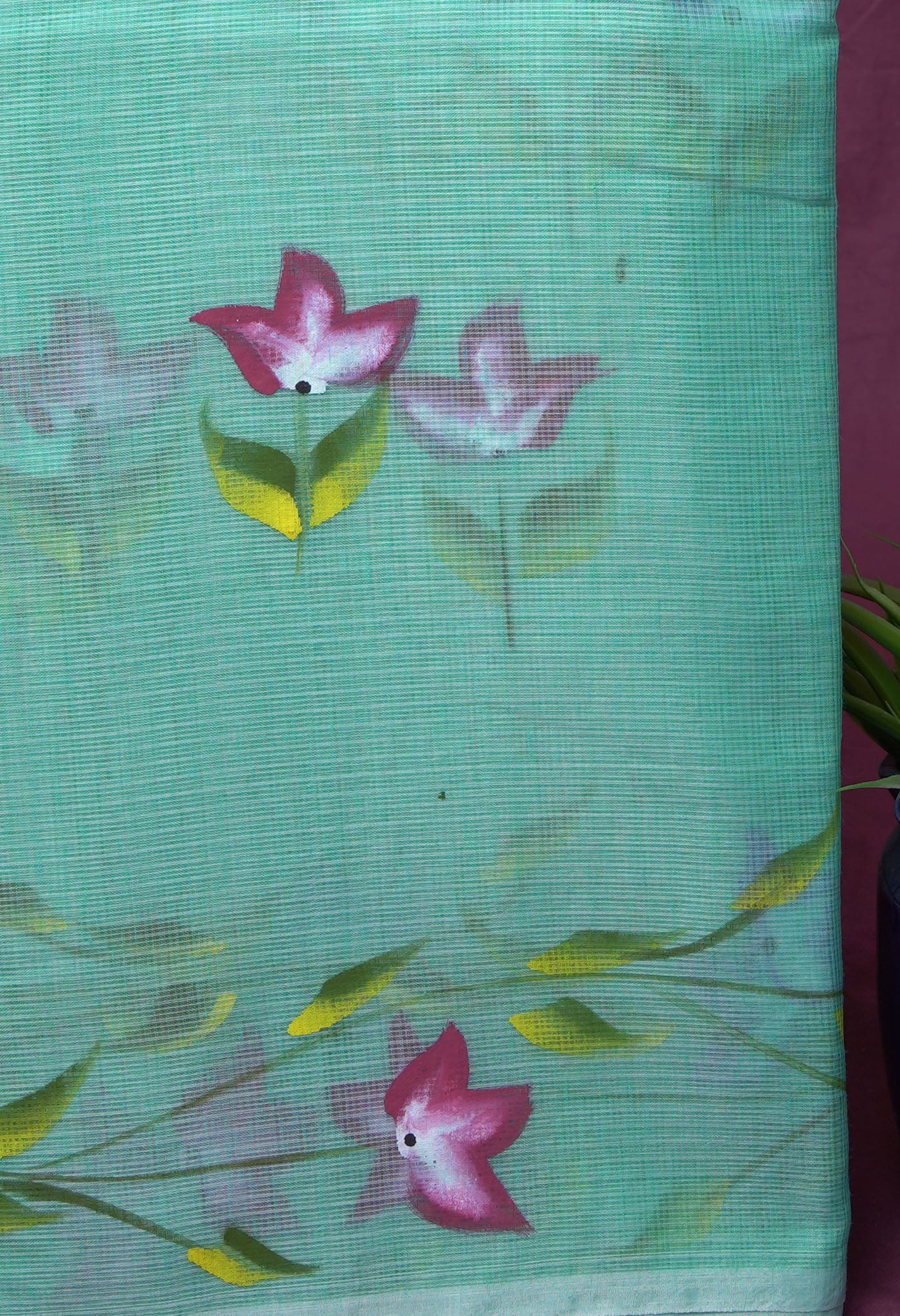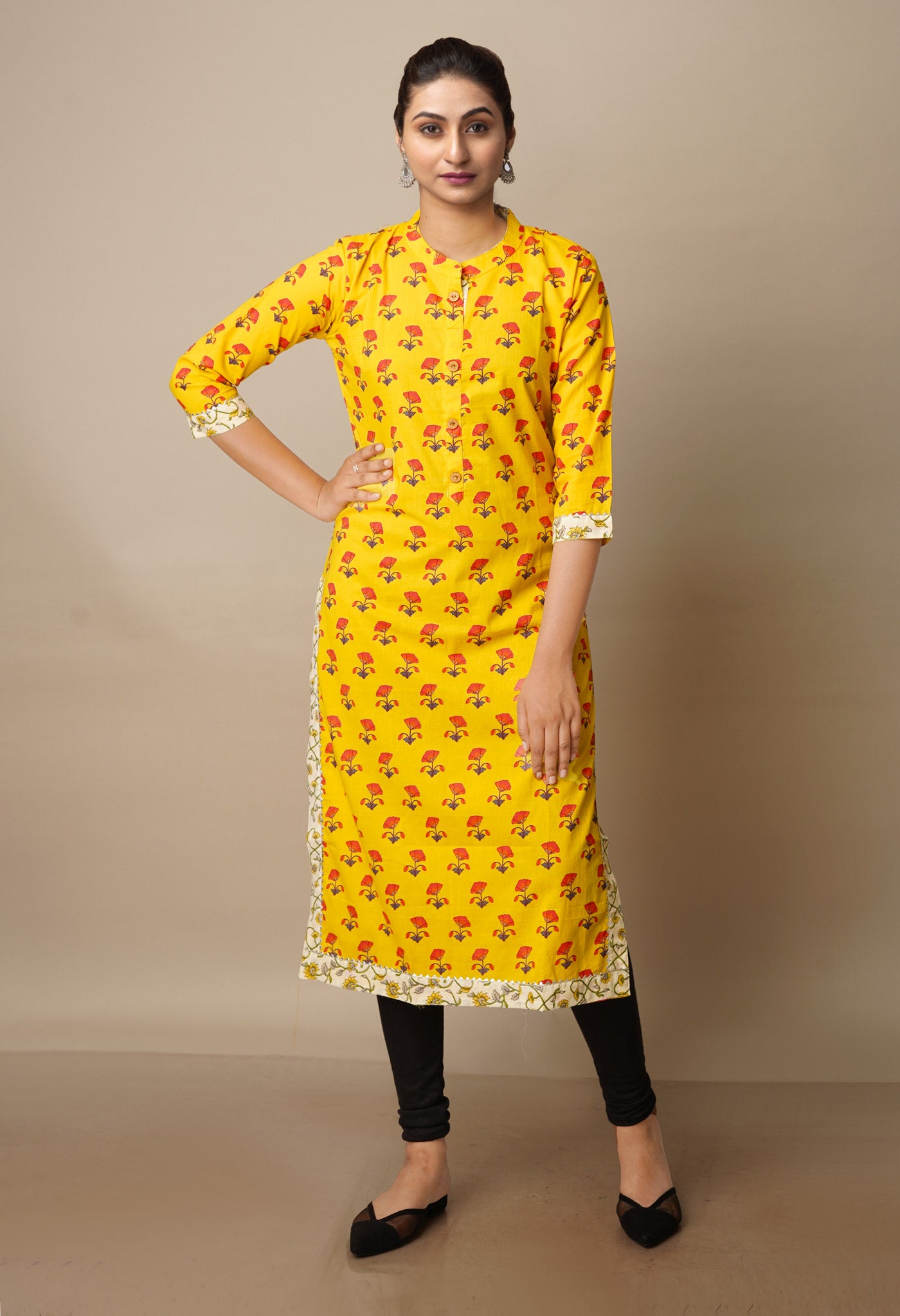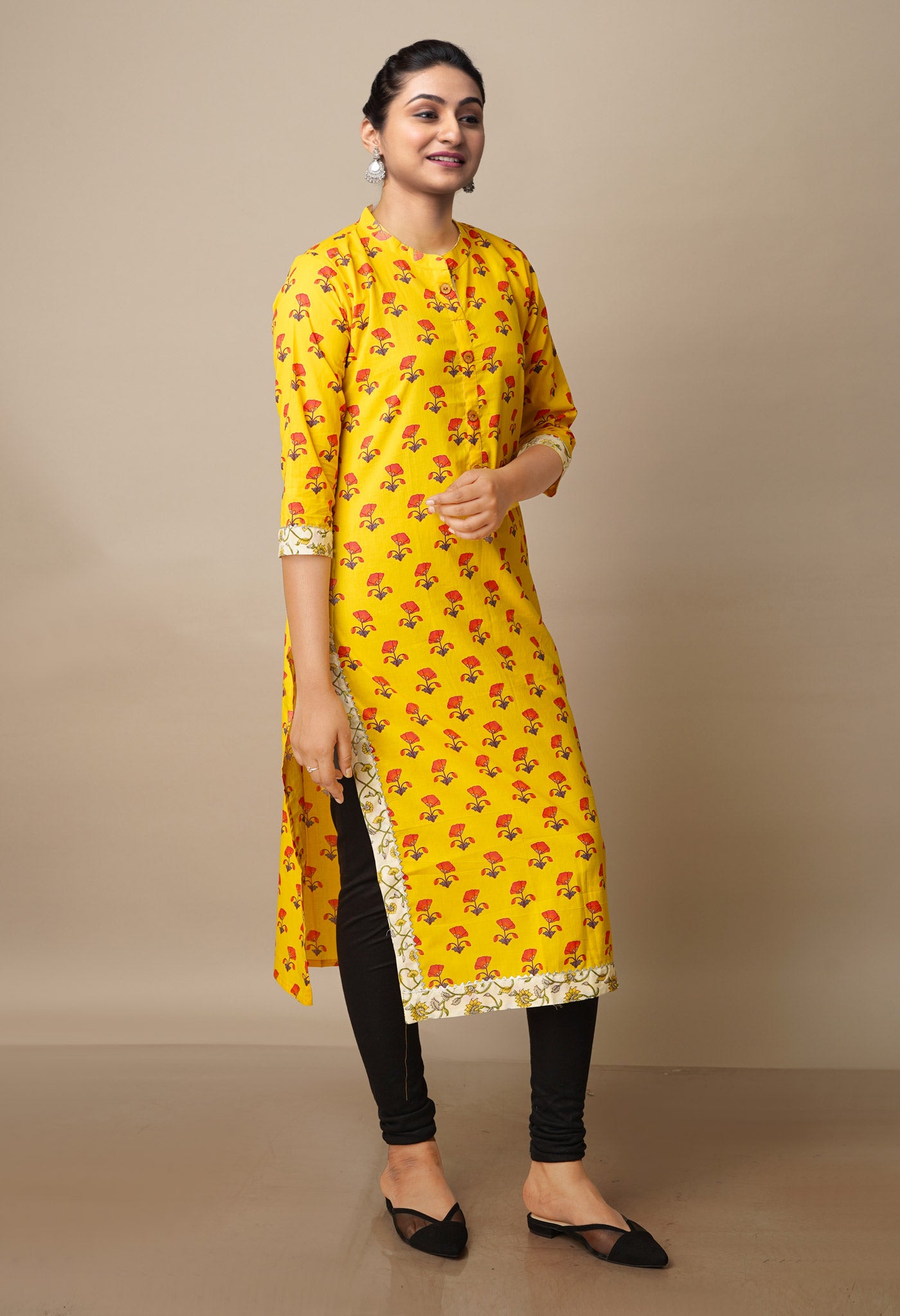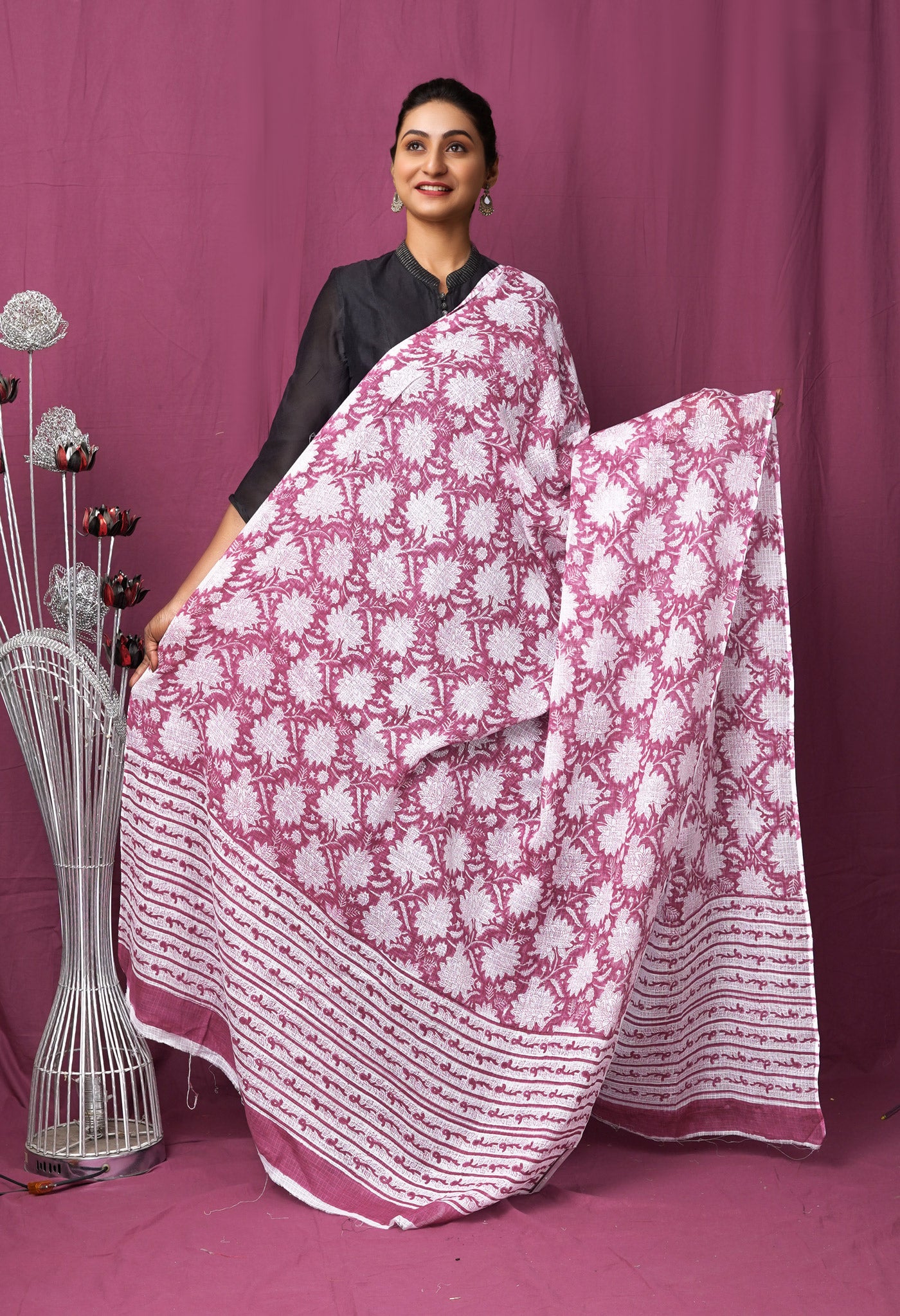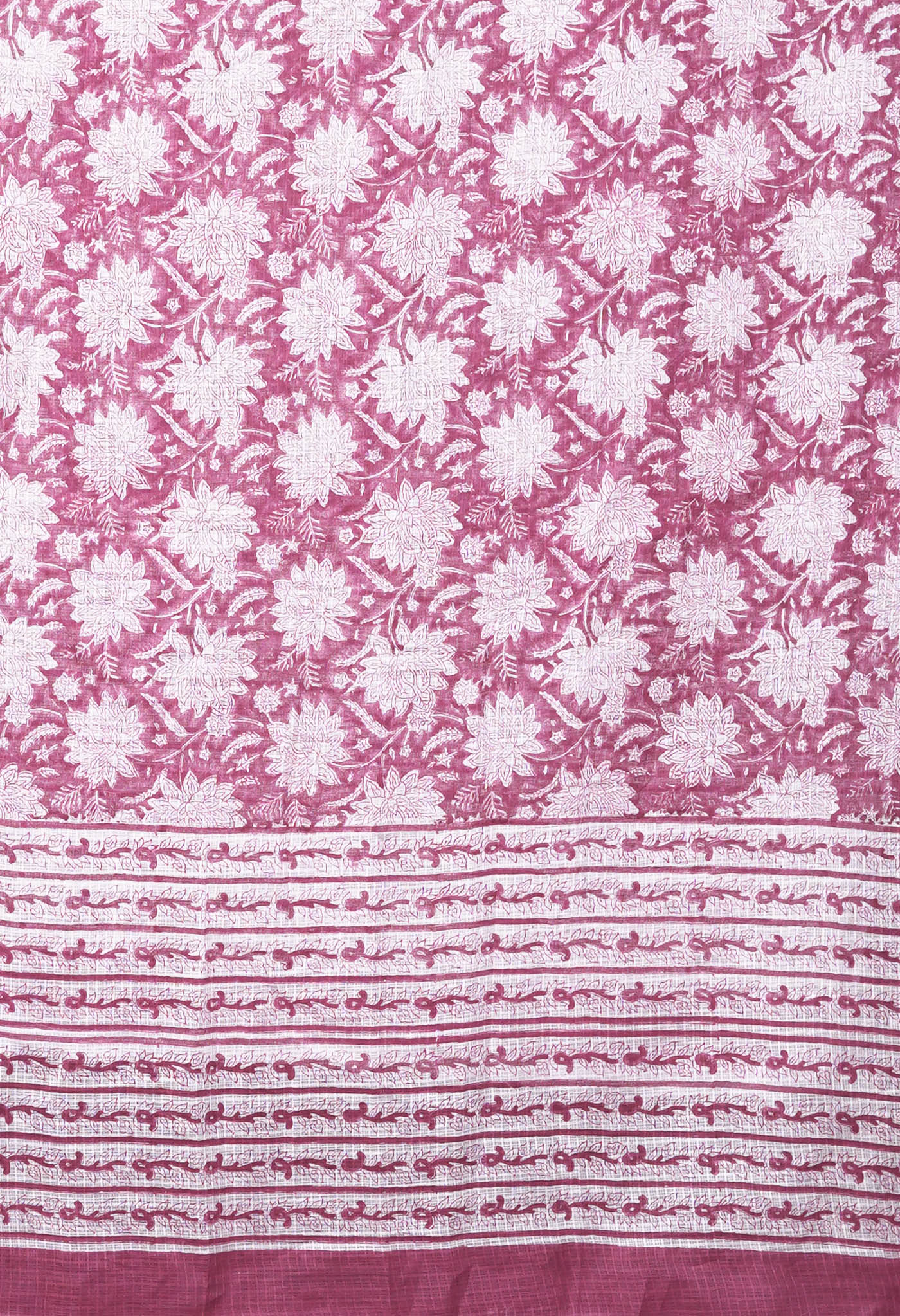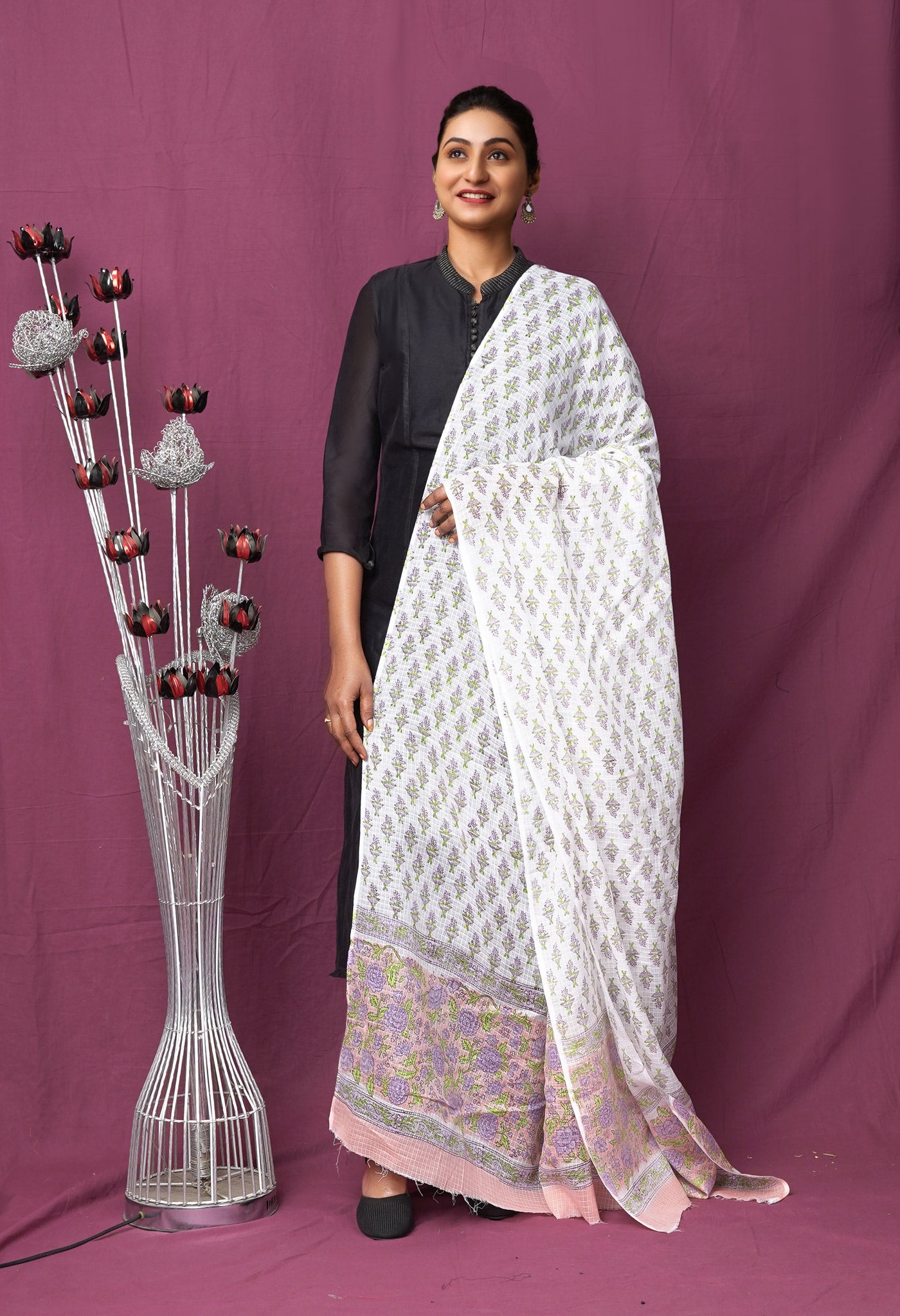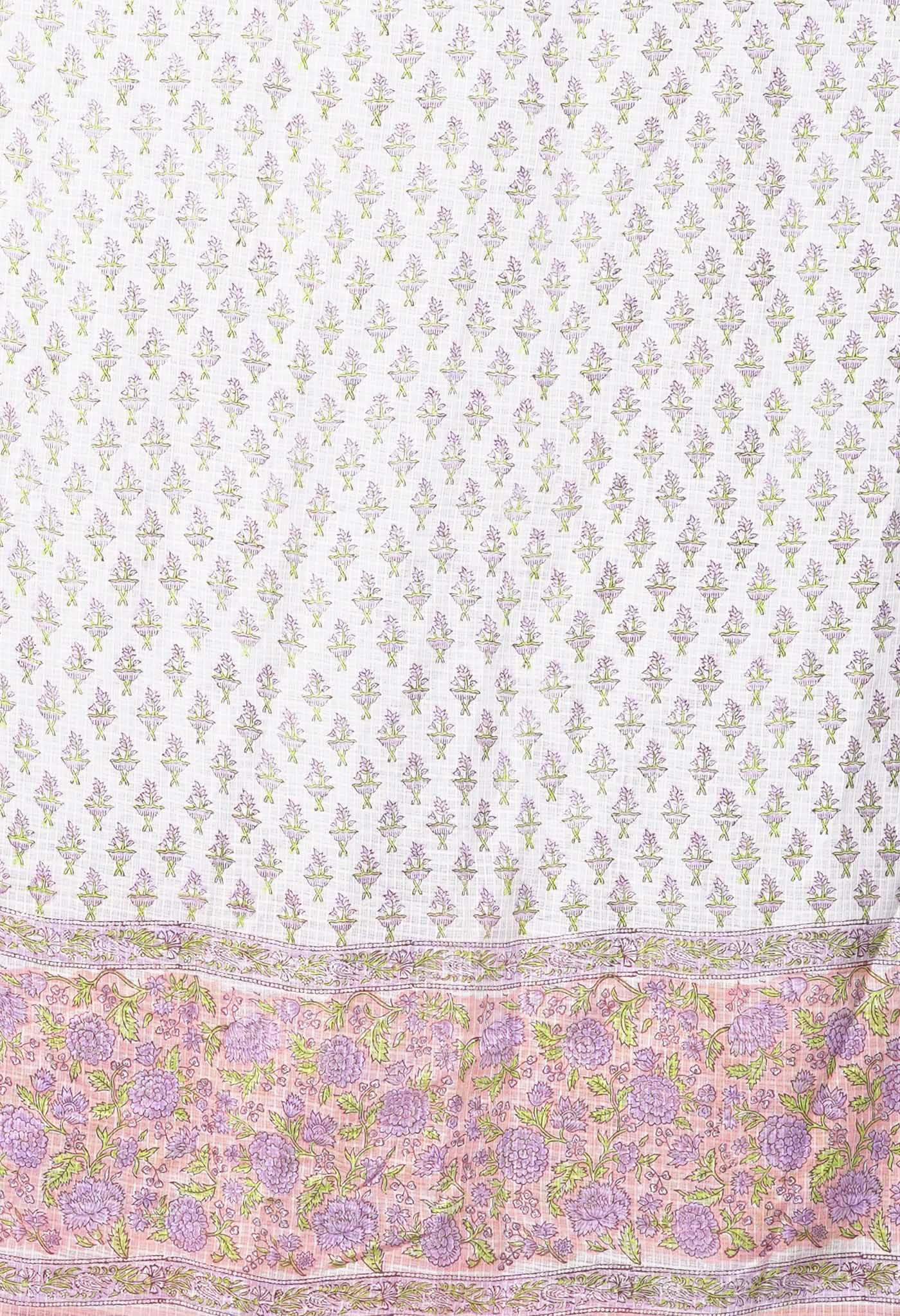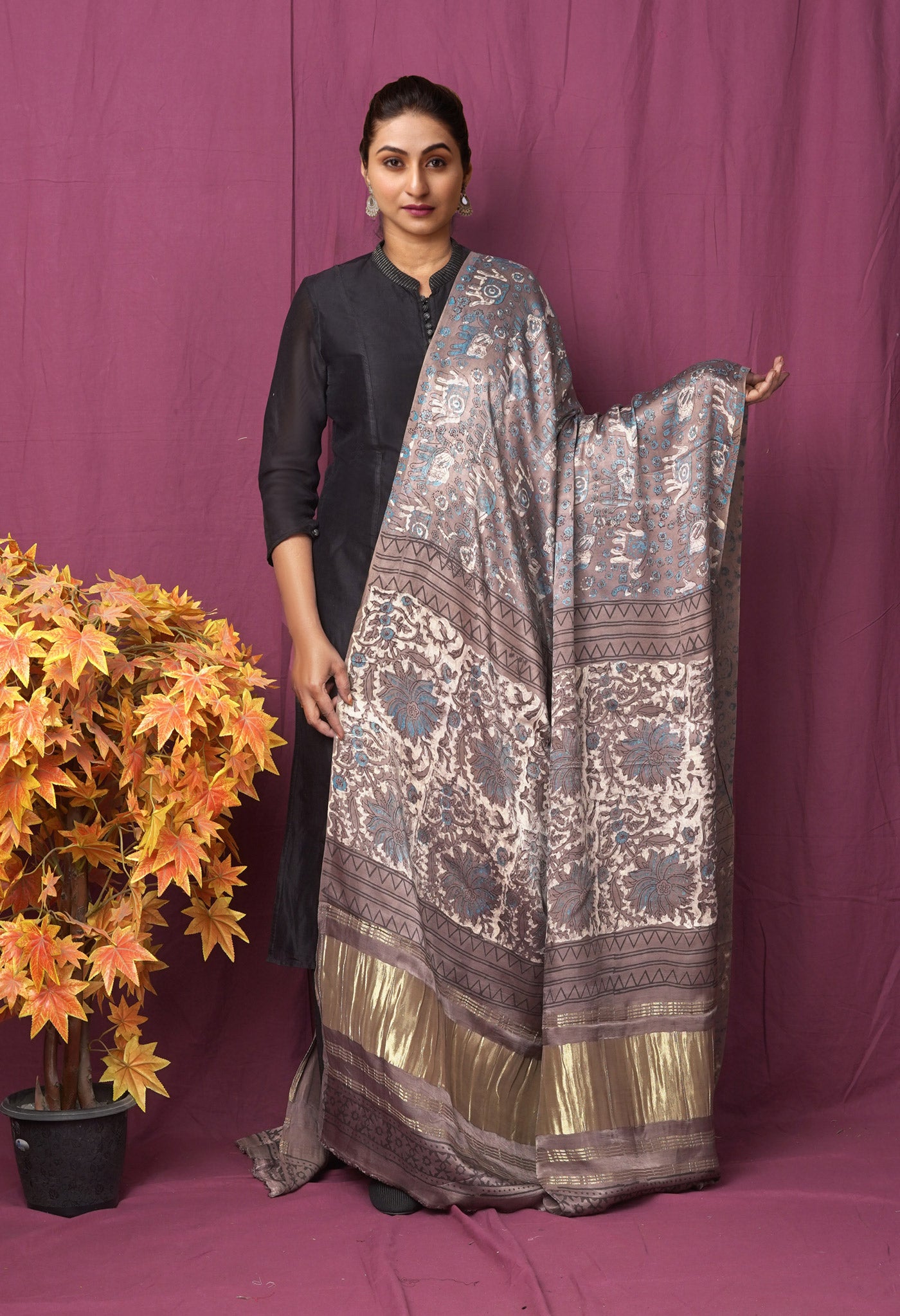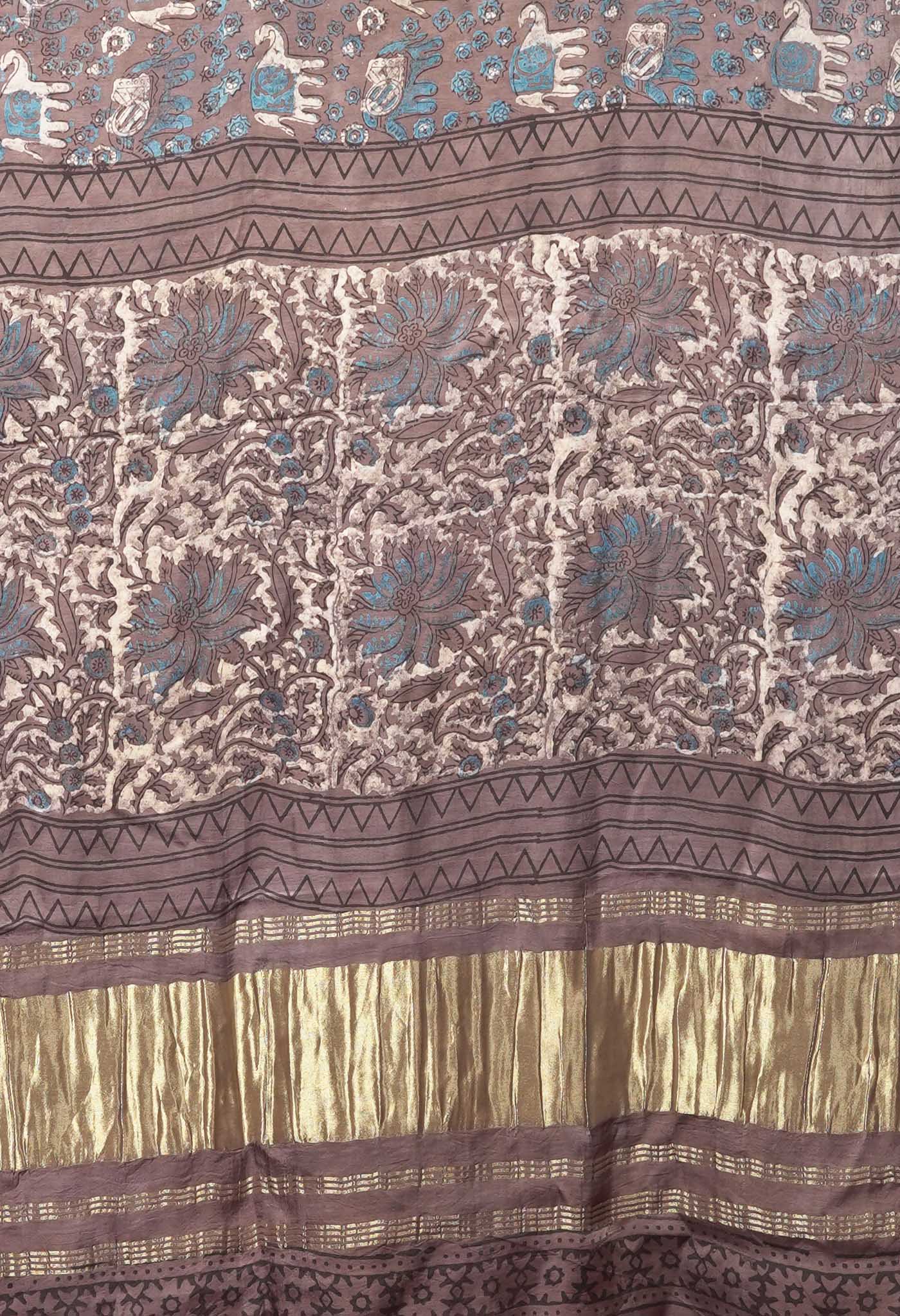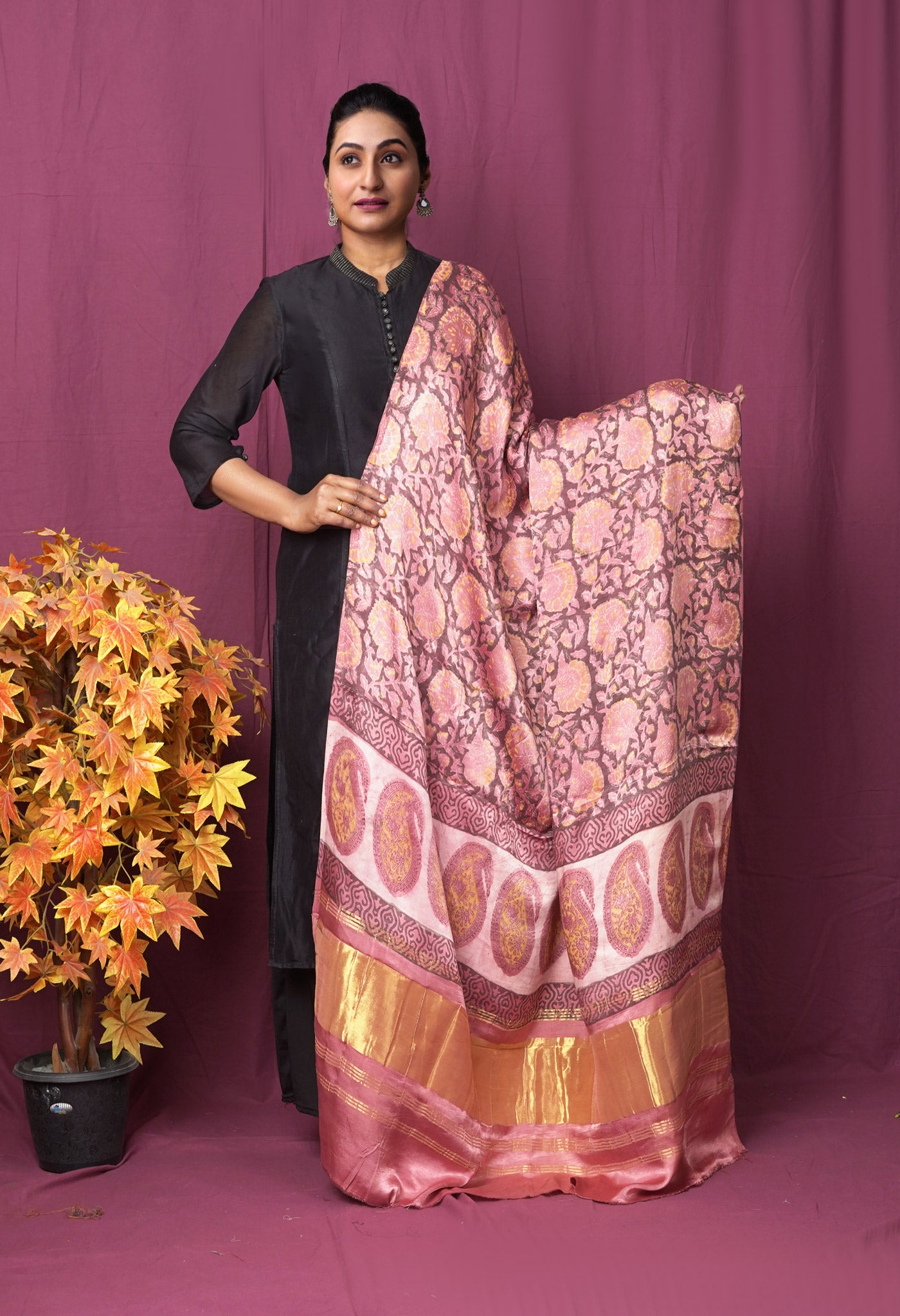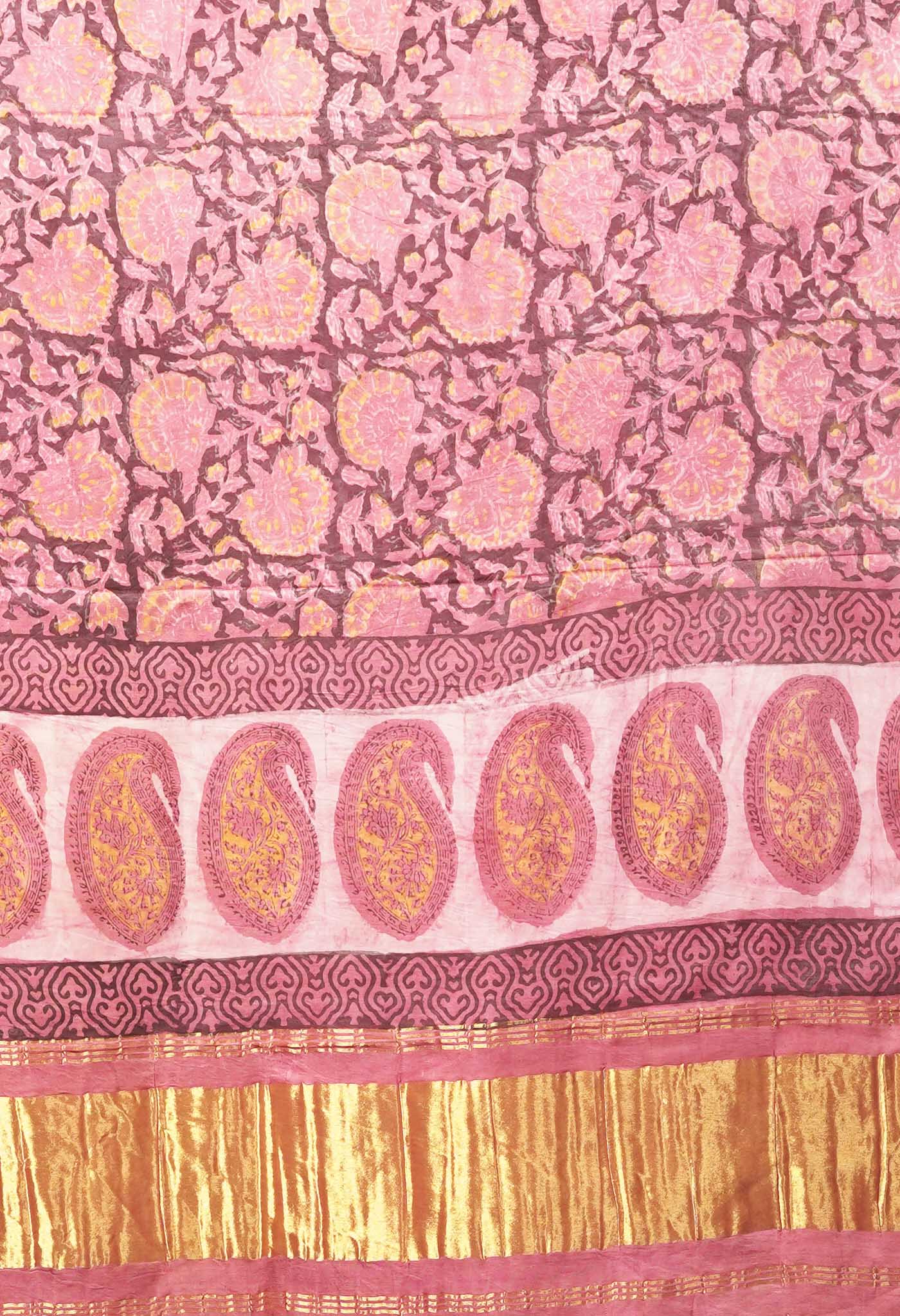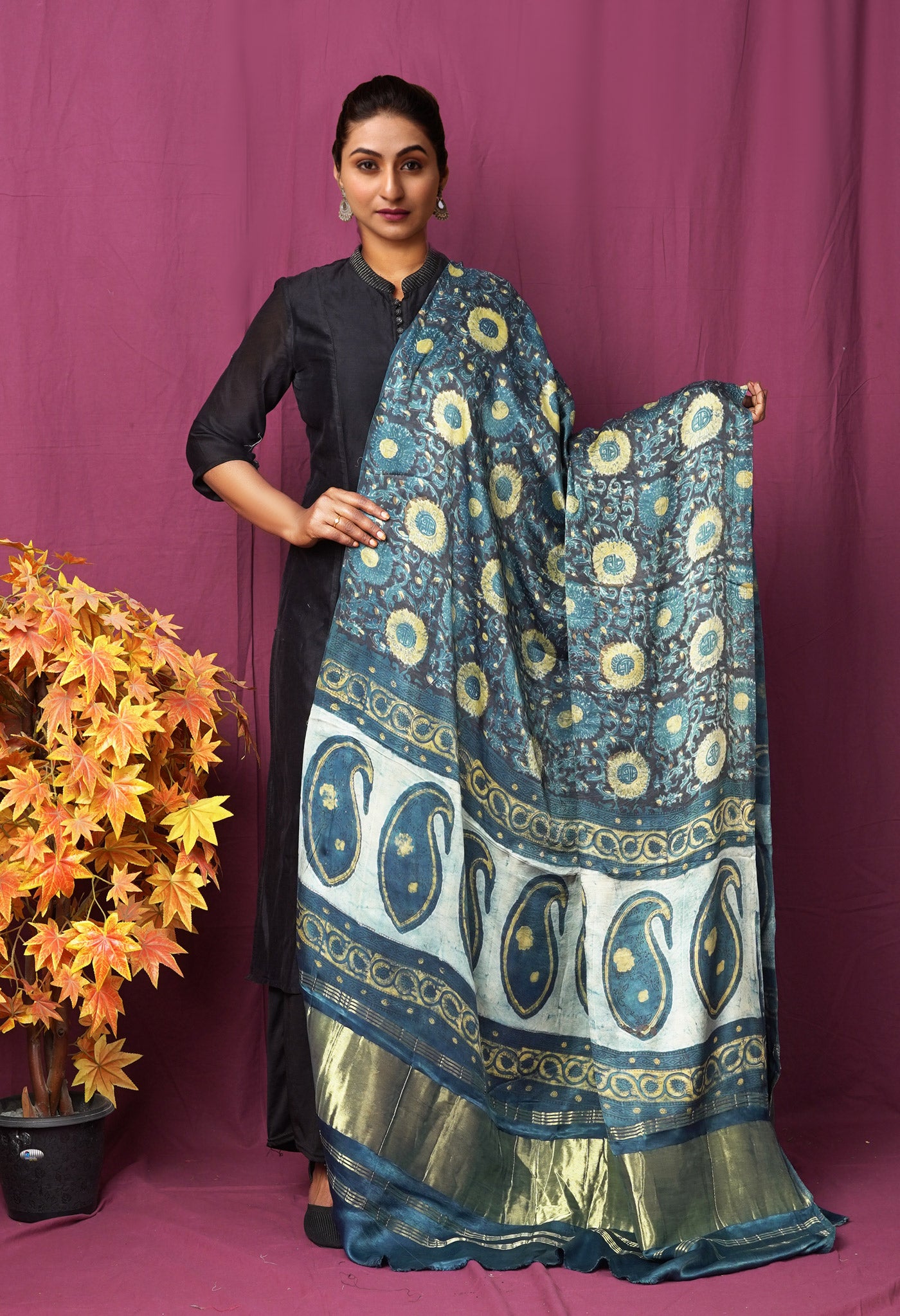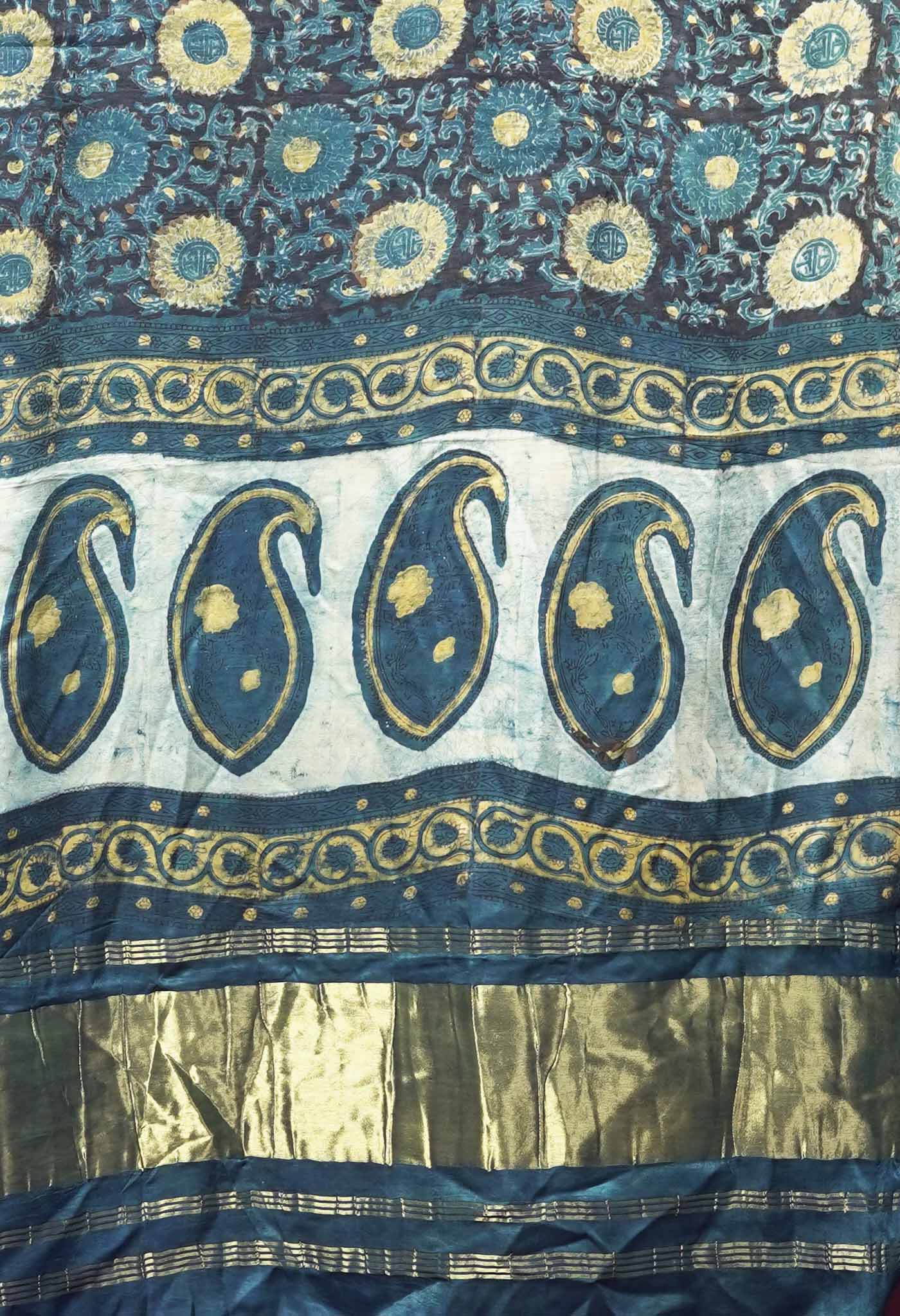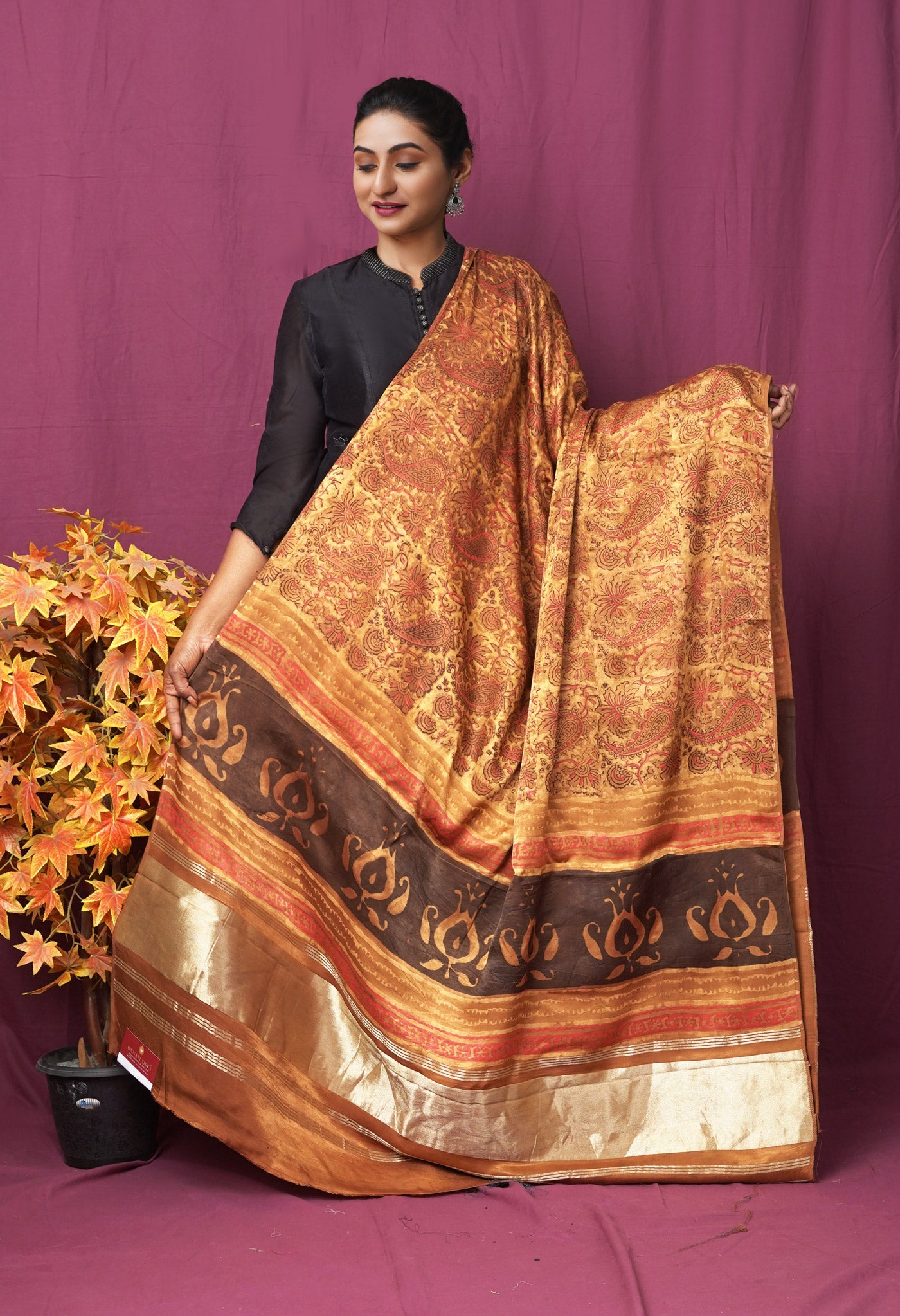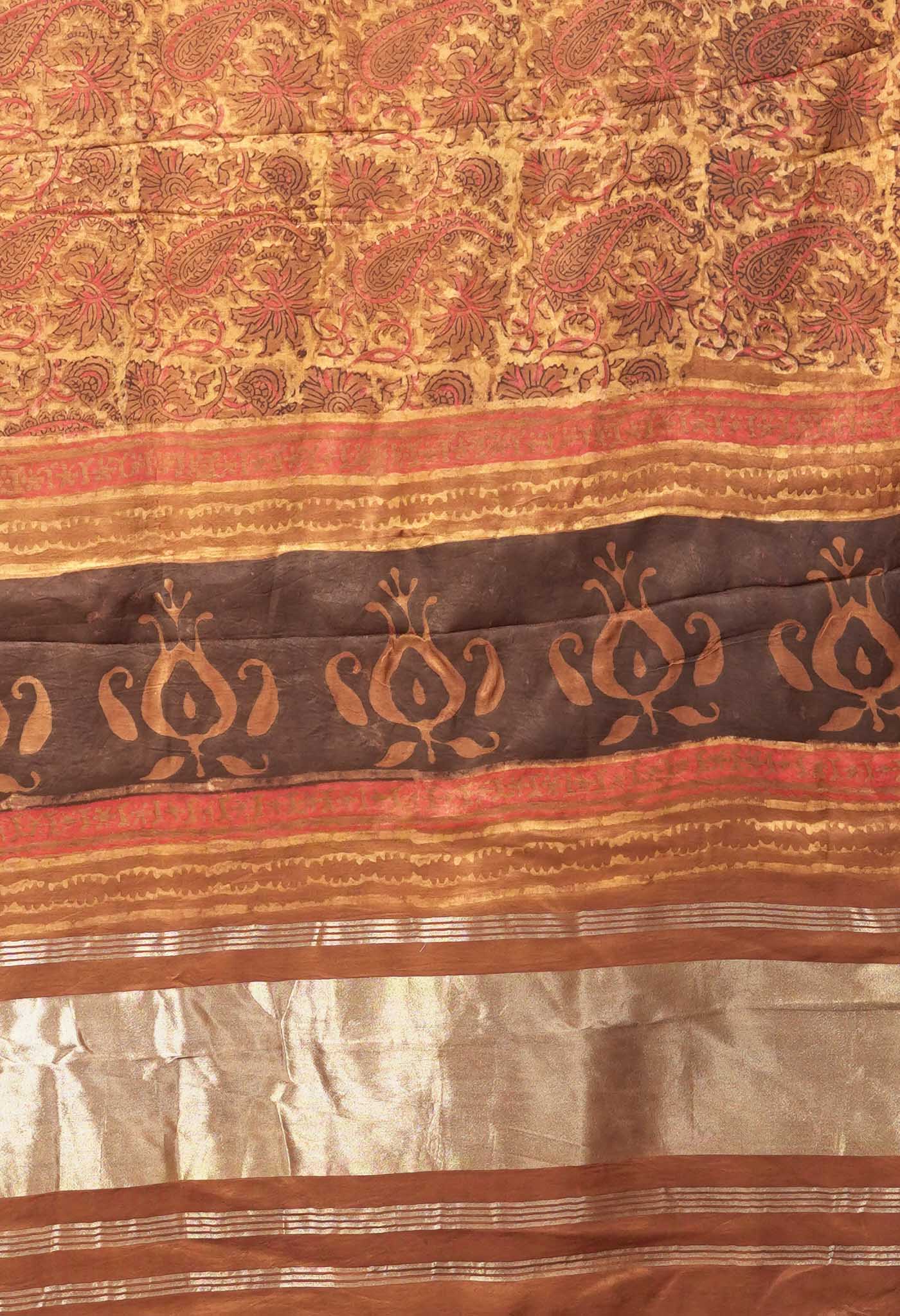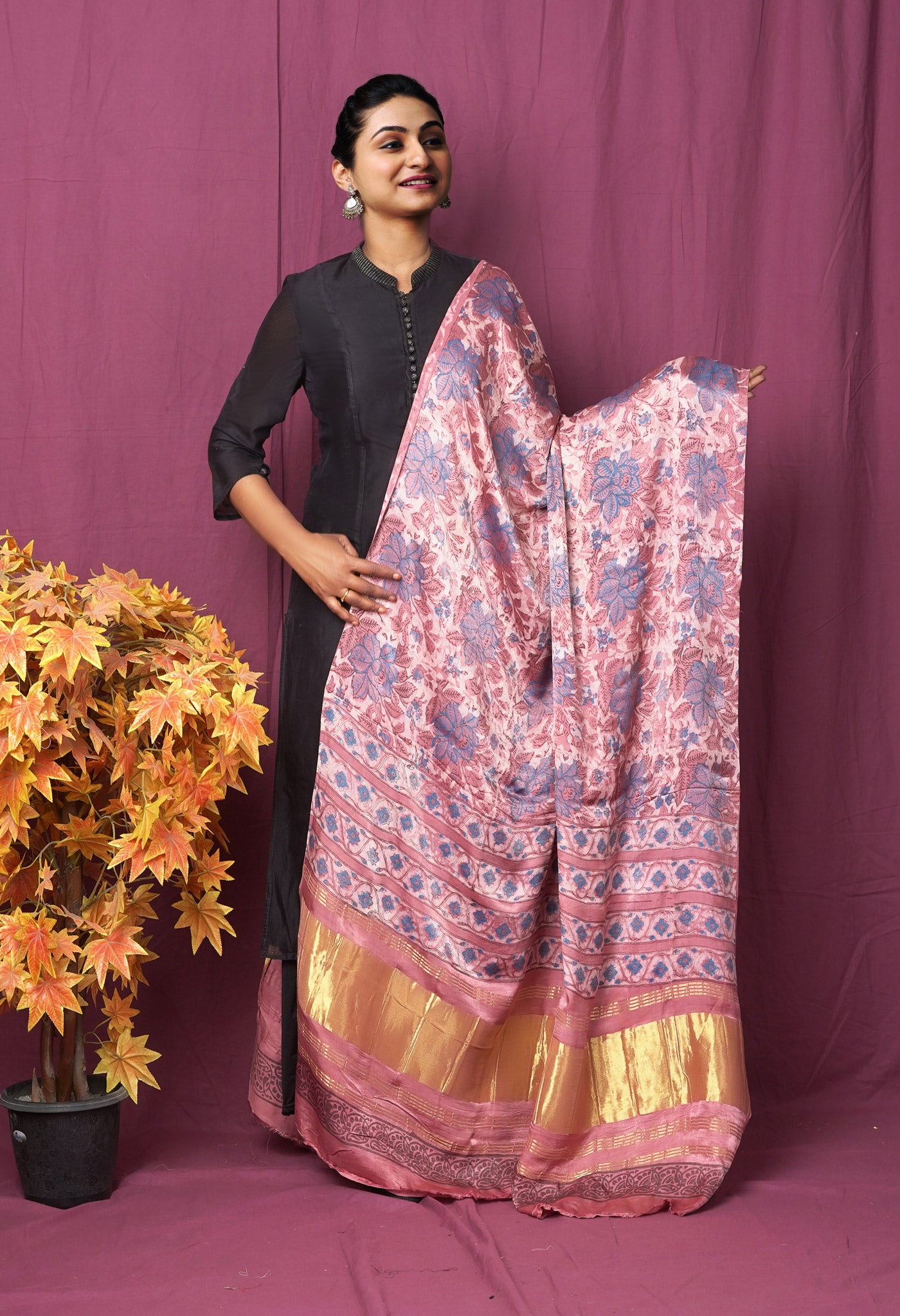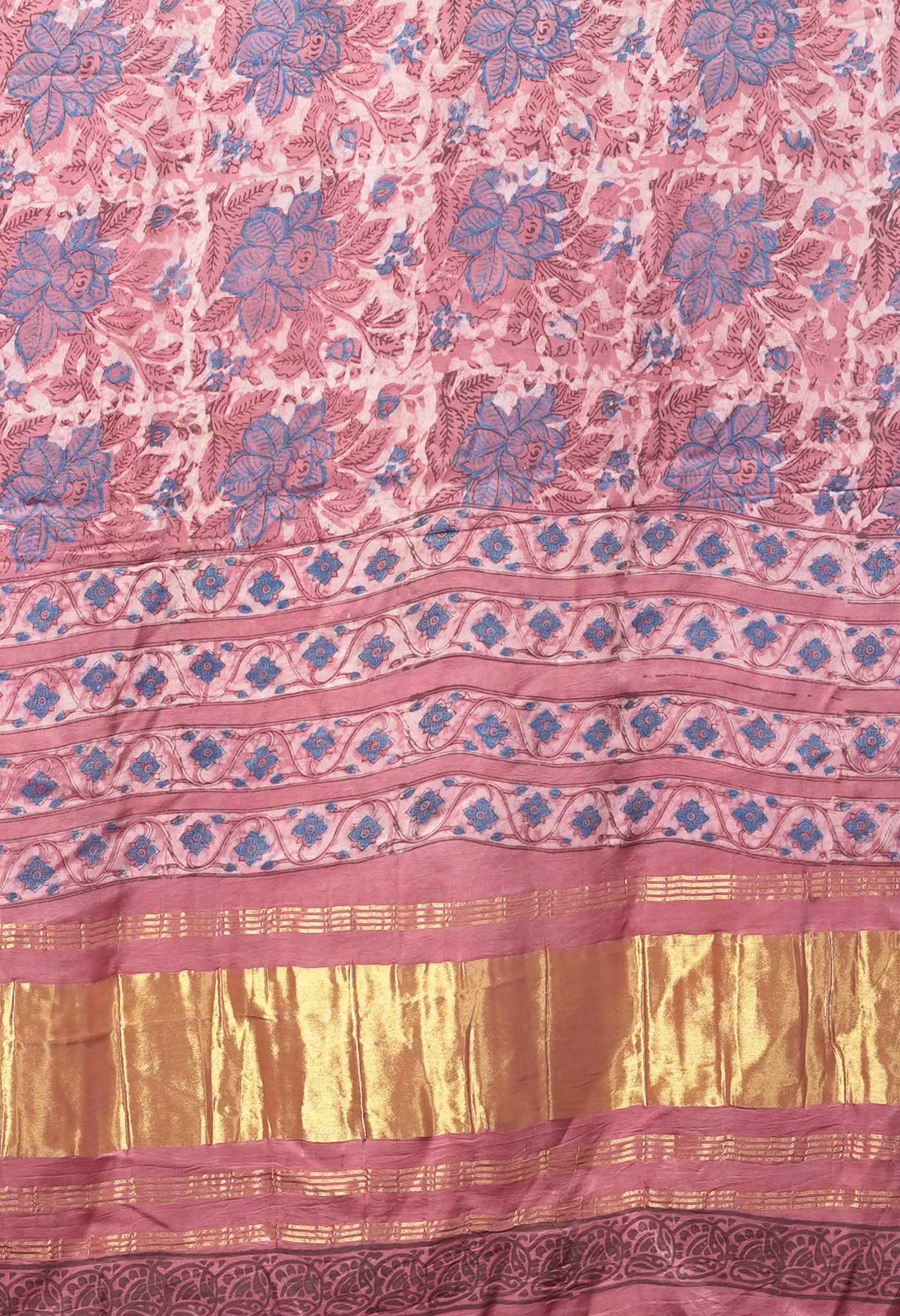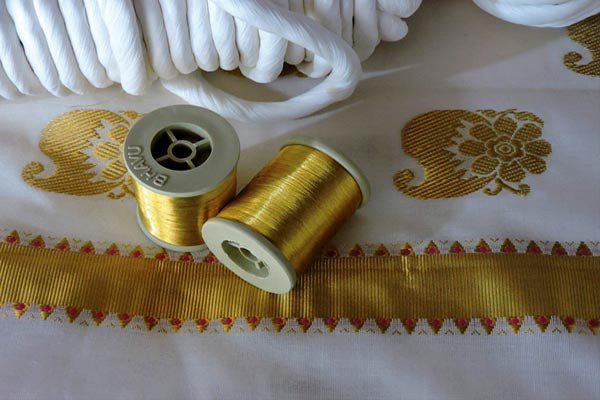
19000 Looms are idle – 20000 Weavers are jobless – Kerala Handlooms on verge of extinction?
Any cultural event, an exclusive wedding or a festive occasion are when you might see the unique and fine Kerala sarees and mundus with a kasavu (gold zari) border. The Kerala mundu and the Kerala saree are typically undyed cotton fabrics with color or kasavu (gold zari) borders and a kasavu stripe on the pallu.

Kerala has traditionally had centres each with their own area of specialization in a certain type of fabric. Balaramapuram, Kuthampully, Chendamangalam, and Kasaragod are these well-known centres. These centres specialize in the plain cotton designs with kasavu or half-fine zari border, while Kasaragod adopts simple patterns and colours. The textile designs have earned geographical indication tags (GI tags) to have them protected as exclusive to the Kerala handloom sarees alone.
Kasargod has many things in common with Mangalore in Karnataka. In fact the Padmashali weavers of Kasargod are originally from Mysore, Karnataka. Though the Kasargod saree is from Kerala, it is different from the traditional Kasavu from the other parts of Kerala. Kasargod sarees are bright and colourful with hardly any ornamentation. Kasargod has a plaid body and solid borders. But design-wise, it is fairly simple. There is a preference in the use of Vat dyes for its fabrics.

Kannur is known for its high- quality furnishing products and accessories in handloom cloth. The traditional set-mundu and sarees of Palakkad are a shoppers’ delight. In 2012, an exhibition had been organised as part of a project for the ‘development of regional brands in handloom industry’ that was being executed by the Kannur-based Indian Institute of Handloom Technology (IIHT). The project aimed at comprehensive development of traditional methods of handloom, their propagation, and marketing.

Kuthampully is famous for cotton fabrics with jacquard golden patterns. Kuthampully sarees, the pride of Thrissur district, are one of the most popular ones with their variety of jacquard designs that set them apart from sarees woven elsewhere in the state. Catering to market tastes but aiming to keep the price down, its use of half-fine zari achieves this and adds to its popularity. Another stand-out feature is that the kasavu border does not extend all of the way to the border, and the unadorned portion stays white. Kuthampully sarees are generally off-white and had once enjoyed the attention of the Kochi royal family.

Kuthampully Handloom Industrial Cooperative Society was registered in Kuthampully village, in the year 1972 with 102 members. They followed the traditional path initially and wove items like kasavu double dhoti, veshti and set mundu . Later on, embroidery techniques have been used on traditional Kuthampully sarees to produce designer to make them designer. At present around 3000 people are employed in this sector mostly through cooperatives and as small-scale entrepreneurs.

The forefathers of Kuthampully came from Mysore five centuries ago for catering to the Royal House of Cochin and stayed over permanently. Each and every house in Kuthampully is supplied with the materials needed for weaving and wages for weaving. Whatever is woven is put up for display in the village shops. Kathakali dancers, Lord Krishna and other popular images figure on the sare.es and made them sought after
At present around 3000 people are employed in this sector mostly through co-operatives and as small-scale entrepreneurs.

The Balaramapuram weavers do not use the jacquard or machines for motifs, but create all designs through detailed needle work. Balaramapuram, has a hold over the traditional kasavu mundu (white cotton dhotis) and settu mundu (or mundum neriyathum) since the times of the royal family of Travancore, in the 18th century when Maharaja Balarama Varma brought weavers from Tamil Nadu to weave clothing for the royal family.Traditional Balaramapuram fabrics make use of a gold zari border and usually with a simple zari stripe at the end. They are typically woven from natural cotton yarn. Of late, weaving the same designs using coloured yarn for the weft, and an increasingly popular mural painting on the sarees – with fabric paints used to recreate traditional Kerala temple art on the pallu have been tried out successfully. Light in weight, coarse by texture the cotton fabric is ideally suited for hot and humid weather that Kerala generally has.

Chennamangalam is mainly known its wide range of dhothis. Handloom fabrics woven in Chendamangalam though like those one finds in Balaramapuram, lay less emphasis on kasavu patterns. Instead, the typical Chendamangalam mundu or settu mundu has coloured borders with a matching colour stripe, with only small amounts of kasavu for ornamentation. The weavers of Chendamangalam had enjoyed the royal patronage of the feudal family of Paliam, who were then serving as chief ministers to the Cochin rulers. Chendamangalam textiles are woven on frame looms, but their texture is slightly heavier than those from Balaramapuram.

The lovely sarees of Kerala
Kerala referred to as 'God's own country' maintains its own traditions, unique and not witnessed anywhere else in the country. The culture and traditions of Kerala are exhibited in the Sarees that are woven. The elegance of the Kerala Sarees with its ever white color along with golden border and the natural texture is dear and prized by all Kerala women. As per the tradition of Kerala, women here are found to be wearing a dress known as 'settu mundu', which is also referred to as 'mundum neriyathum' having natural color of body and different beautiful shades of border. The significant part about the traditional Kerala saree is that once they woven only by hands and the cotton used was 100% unbleached. With fine intricate designs, excellent craftsmanship, the bright simplicity of colours and the lovely texture of the fabric are what makes Kerala handloom products so special. Even today barring small changes like the inclusion of fine thread work on the fabric, owing to market considerations, the tradition remains intact.

The typical saree of Kerala consists of 1-7 inch pallu whereas the rest of the body is found plain. There are beautifully decorated designs of prints such as flowers and peacocks found on the one meter pallu and can be availed in stripes, checks along with a number of designs found in cotton or mixed with silk.
The outfit of men found in Kerala is dhotis or Kasavu mundu during the festivals or special occasions. The kora cloth or the unbleached cotton with handloom crepe fabric, has been popular universally.
But what is the current status as regards the Kerala Handloom industry?
Kerala has a very long standing tradition of weaving and handloom production. Over the years the industry has suffered by way of decreasing numbers in the weaving class, fall in quality of work, low wages, and a host of other reasons. On the one hand
There are according to reliable sources, 20000 weavers and 19000 looms are idle. K Sudhir, Director, Handloom and Textiles, had said “Kerala had around 2 lakh weavers before 2000s; the number reduced to around 50,000 in the early 2000s and has now dwindled to around 20,000. Apart from low wages, the industry faces tough competition from Tamil Nadu as their products are priced at a much lower rate”.

What ails the Kerala Handloom Industry?
The handloom industry of Kerala is split into three categories. According to the government officials, weavers across the state are mainly categorised into three sections – weavers under government textile societies and units, weavers under textile society and private firm partnership, and weavers who work only with private firms.
There are a host of reasons that have contributed to a fall from traditional glory to struggle for survival.
- The total weavers registered under government handloom societies are close to 48%. Most of them are 50 years of age and above. They suffer from health-related issues such as suffocation, nose block, wheezing/asthma, joint pain, etc. because of the long hours of arduous work.
- Unfortunately the wages are comparatively very low for their effort. One woman who had 57 years of experience in weaving, her monthly income is today only between Rs 2500 and Rs 3000, based upon her delivery of the allotted work.
- The astonishing fact is that it is a woman-dominated industry with 3/4ths of the total workforce being women and young girls. Only about 20 to 22 % of them are males. Being the source of livelihood as well as mainstays of their families it is a tremendous burden on the womenfolk. Yet they have grit and courage to pull on despite the tremendous odds.
- One of the main reasons that progeny of the weavers are not willing to continue the tradition of their parents is the dismal returns for the back-breaking efforts that go into churning out excellent weaves that have been the pride of Kerala. So when a weaver attains pensionable age replacement becomes difficult.
- As per reports, there have been months when no employment could be generated due to lack of resources and raw materials. The raw materials needed for weaving include yarn, kasavu, colour, gum, oil, etc.
- Under these harsh conditions the profit from this business is almost nil. Sometimes employers can’t even afford to pay the weavers and their salary gets delayed for several months. From their meager salary, 6% is cut as share to run the society they are members of.
- Not knowing any other skilled occupation like what they already know, if they are out of work there is no alternative but to seek menial jobs just for their day to day existence.
- There are numerous cases of helplessness and misery of many textile societies. If one were sensitive enough on hearing their tales tears could well up in one’s eyes. There are many more who are not registered under government textile societies and whose plight is real bad. Yet whom can they go to since they are not even heard.
- If this be the fate of the weavers then the spinners are worse off. Spinners are workers who make yarn using the traditional spinning wheels. Their wages are as low as Rs 1000 a month. When weavers get poor eyesight they in order to survive have to depend on this task alone to stay within the ambit of the industry.

Has the govt. done anything for them by way of policies and initiatives?
Govts. Have come and gone but there has been no acknowledgement of the fact that Kerala enjoyed a rich tradition of royalty and who had encouraged handlooms. Kerala weaves have enjoyed a unique distinction for their regal looking handloom fabrics. If there is acknowledgement there has been no encouragement through sound policies that could infuse life into a sick and ailing industry.
E.g. if one were to see other governments like Telangana and Tamil Nadu trying their mite to revive the glory of their illustrious handlooms through initiatives and weaver friendly policies, the Kerala government could follow suit.
The present situation that meets the eye is a far cry from what was envisaged. The ground reality of today states that only 20000 remain owing to the various ills that plagued the industry. So is it that everything seems rosy on paper, while the beleaguered section of handloom weavers languish in their continued misery? Well surprisingly based on the govt. reports the latter seems to be true.
Of course a recent policy of getting together the retailers and wholesalers of Kerala and other stakeholders like the weavers, artisans, NGOs and other important sections of society together in a meeting, and having the scheme of school uniform fabrics woven by handloom weavers has slightly alleviated the misery of these ethnic practitioners but much remains to be done if the glory of the Kerala handloom sector has to be restored, the young weavers who have been discouraged by the existing ground situation have to return to the fold and continue the fine tradition of the craft.

The useful advice of getting the traditional sarees geographical Indication tagged has also helped to an extent. But despite this the competition of the art silk industry and the unfair practice of cheaper imitations or spurious products has delivered heavy blows to the genuine handlooms.
There was a time a few years away, when 1.25 lakh weavers got their employment from more than 750 cooperative societies as well as 50000 handlooms falling under the private sector. Department of Handlooms and Textiles are assisted by the Kerala State Handloom Weavers Cooperative Society (HANTEX), which is a top cooperative organization along with Kerala State Handloom Development Corporation Ltd (HANVEEV) that offers services to weavers individually.
Hantex was having a wide network of 150 showrooms situated in important parts of state. The aim of Hantex was to meet the standards of domestic as well as international markets, through creative and intricate breathtaking designs. Hantex had also started with a great computerized Design Department which enabled the weavers to evolve and put in more sophistication as far as designs of printing or weaving were concerned. Much was tried out through 150 imported machines used to cater to the needs of export and handcrafted fabrics, furnishing, garments, made-ups, traditional wears, sarees etc. These were being produced through modern infrastructure taking into consideration the global eco friendly norms.
In the near past, Hanveev offers school uniforms in a variety of shades for eco friendly uniform cloth catering to the needs of different School requirements around 100 schools in the state. The uniforms for Industrial workmen, hospital staffs, Police are also supplied by HANVEEV. Besides this, Hanveev manufactures Hospital Bed sheets, aprons, Gloves, operation theatre masks, caps etc for Doctors and Nurses etc. “Handloom Processing House” at Chirakkal, provides a large range of uniforms made up of 100% cotton or Polyester Cotton Blended fabrics.

Going online with their products
A recent move of the Handloom weavers of Kannur, is that they have started selling products including shirts with traditional designs through e-commerce giants like Amazon. The district administration has initiated steps to help the handloom sector by having weavers trained in creating attractive designs and helping them tie up with e-commerce giant Amazon to start with to get a wider and direct market for their products.
The “Cannloom” brand products which include men’s formal shirts in cotton and linen and with traditional designs of Kerala’s popular martial art “Kalaripayattu” and “Theyyam” (a popular ritual form of worship of North Kerala) and cotton dhotis, are already being sold on Amazon.
Recently 80 weavers and workers of Kuthuparamba Weavers Cooperative Society had gone online with the two products while 16 other weavers’ societies had completed training at National Institute of Fashion Technology (NIFT) and would launch their products online. Launching the products on a major platform like Amazon was a bold step.
“We started by designing attractive handloom bags and as we moved on we wanted to combine looms and lores of the region and thought of taking “Kalaripayattu” and “Theyyam” motifs, which are part of Kannur’s tradition,” he said.
Sarees, towels and bags with unique traditional designs of Kannur online, he said. “We are in talks with Amazon to reduce their fees which will cut prices by 10-12 per cent,” he said.
So far, the handloom products were being sold across the counter with sales being significant only during the festival seasons of Onam and Christmas. The new endeavour will help remove middlemen with benefits going directly to society’s weavers.
Kuthuparamba Weavers Cooperative Society secretary had already mentioned of products worth Rs 15,000 having already been sold by selling through Amazon. “There is good demand for the products and weavers have realised that with changing times and habits, there is need to incorporate new designs to attract more customers,” he said. There are also plans to sell products through Flipkart and Myntra.

Unnati Silks and Kerala Handlooms
When a media journalist asked Mr.Devender Ladha what he thought about the handlooms of Kerala, he smiled and remarked, “If one were to know the worth of traditional handloom fabrics, one would realize their tremendous worth as India’s heritage and pride – their immense contribution in earning attention and admiration the world over as unique ethnic offerings, worth every thread on them.”
“Unnati Silks has chosen to back handlooms all the way and has been doing so since 1980. Every handloom variety from Kashmir to Kanyakumari, is viewed by us as an immense work of art that should get its due if the art and craft have to continue in time as eternal traditions to be treasured and sustained in the history of Indian fabrics. We pride ourselves in having both offline and online, handloom varieties from 21 states of India. The handlooms of Kerala are well known to us, have a special place in our hearts for their uniqueness and it saddens us that a fine tradition that had seen the patronage of different royal dynasties should come down so much in life, where the practitioners are leading an almost hand-to-mouth existence”.
[gallery size="medium" ids="16651,16653,16652,16659,16655,16656,16658,16657"]
“Tradition is a fine thing only if the legacy is sustained through generation on generation of craftsmen, amply encouraged by demand from the market and rewards proportionate to their effort.”
[vc_row][vc_column][vc_btn title="Shop Online Kerala Handloom Cotton and Silk Sarees" color="info" link="url:https%3A%2F%2Fwww.unnatisilks.com%2Fsarees-online%2Fby-popular-variety-name-sarees%2Fkerala-cotton.html||target:%20_blank"][/vc_column][/vc_row]

